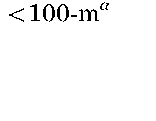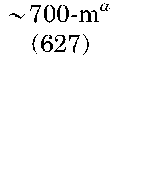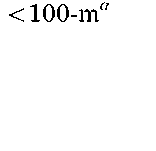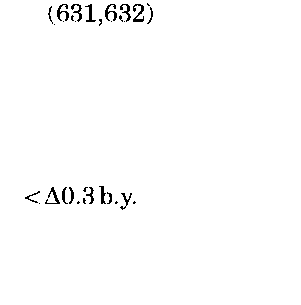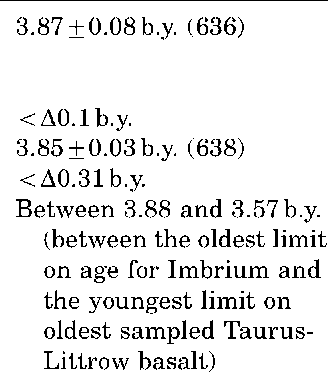Apollo 17 was not the last flight of humans to the Moon. This writer was not the last human being to step on the lunar surface. More lunar exploration and even lunar settlement will occur, baring the future stagnation or disappearance of our civilization. Exploration and scientific investigations in the earth sciences are rarely complete, particularly for studies related to a specific field site. A long hiatus between field investigations may occur, but other forms of investigation, directly or indirectly related, continue. Apollo 17′s field study of the Valley of Taurus-Littrow on the Moon in 1972 and subsequent examination of its significance to our understanding of the origin and evolution of that small planet and of our own constitute a good example of these facts of scientific life. As the third of the specifically “science” missions to the Moon in the twentieth century, Apollo 17 actually became the last lunar landing of the Apollo Program in September 1970 (1) rather than on 11 December 1972 when the mission reached Taurus-Littrow. The National Aeronautics and Space Administration (NASA) and the Administration of President Richard M. Nixon, with the acquiescence of the Congress, had concluded that no further planned amortization of the American taxpayer’s investment in deep space exploration would be undertaken. As historically naive a political decision as this may seem today to some, it did not prevent the achievement of one of the Program’s major goals—gaining a first-order understanding of the Moon and its relationships to the terrestrial planets. This became one of the primary historical legacies of the post-World War II generation.
Apollo had evolved quickly and radically toward increased scientific emphasis after Neil Armstrong first stepped on the Moon on 20 July 1969. Its purpose changed from the completed goal of meeting President John F. Kennedy’s challenge (2) to land ”men on the Moon and return them safely to Earth,” to an objective of increasing human knowledge about the Moon and space. This would be done to the maximum extent possible using the technological and operational systems in hand and reasonable extensions of that capability. This shift in emphasis occurred smoothly and rapidly thanks to the foresight of senior NASA managers such as George M. Low, Apollo Spacecraft Program Manager; Robert Gilruth, Director of the Manned Spacecraft Center; Eugene Kranz, Chief of the Flight Control Division; Maxime Faget, Chief Engineer of the Manned Spacecraft Center; and General Samuel Phillips, Director of the Apollo Program. As early as the spring of 1969 (3), scientific packages were being enhanced, adding new experiments and improving old ones. Astronaut training in field geology, overseen by the author for the Astronaut Office, was altered to consist of field simulations (4) at geologically relevant sites using mission-specific equipment and procedures. These scientific training exercises taught pilots the art of geologic observation, sampling, and documentation and also put that learning in the context of real geologic problems related directly or indirectly to those they would encounter on the Moon. In addition to the U.S. Geological Survey’s Principal Investigators for field geology, Eugene M. Shoemaker, Gordon A. Swann, and William R. Muehlberger (also of the University of Texas), world-renowned Earth scientists who doubled as outstanding teachers were given increased access to mission planning, mission operations, and astronaut training. These new participants included Richard H. Jahns (Stanford University), Robert P. Sharp and Leon T. Silver (California Institute of Technology), James B. Thompson and James Hays (Harvard University), and Gene Simmons and William Brace (Massachusetts Institute of Technology). Also important to science was an increase in the capability of the Lunar Module (5) so later missions could include heavier scientific payloads, a lunar roving vehicle, and greater consumables, thus, longer time on the Moon. These augmentations meant a large increase both in time for exploration (22 hours for Apollo 17 versus a total of 19.4 hours for Apollo 11, 12, and 14, combined) and in distance traveled (35 km for Apollo 17 versus ~5km combined walking distance for Apollo 11, 12, and 14).
The Apollo 11, 12, and 14 missions were flown largely under the original payload, training, and operational constraints imposed by the race to the Moon and the conservatism necessary for success in that race. These missions still managed, however, to produce remarkable suites of samples, photographs, and observations in addition to giving the Apollo team the operational confidence to land at more challenging but scientifically more interesting locations away from the lunar equator. In spite of the operational limitations, the analysis of samples and other information returned from the first three landing sites rapidly increased the understanding of the Moon and its history. Ironically, the Apollo 13 mission, which failed to land on the Moon, set the stage for the even more spectacular scientific returns from the last three landings, Apollo 15, 16, and 17. The crew and backup crew of Apollo 13 had embraced the new training emphasis on field geology and encouraged the Apollo 15 crew to follow suit. Apollo 13′s backup crew, already convinced that a science focus was important, was assigned to fly the Apollo 16 mission. Finally, the designation of a scientist and geologist as the Lunar Module Pilot on Apollo 17 assured that all of the last three missions truly would be ”The Great Voyages of Exploration” (6).
Due to the foreknowledge that Apollo 17 would be the last of the Apollo series, selection of its landing site became a contentious issue (7) among lunar scientists and between lunar scientists and operational planners. The usual candidates for landing sites reappeared: crater floor and central peak opportunities for deep sampling of the lunar crust, like the impact crater Copernicus; possible volcanic features, like the Davy Crater Chain and dark material in Alphonsus; and highland areas such as the rim of the crater Tycho and an area ”Southwest of Crisium.” Even a farside landing in the basin Tsiolkovskiy was given brief consideration due to the efforts of the author (8). Eventually, however, the scientists became increasingly interested in an unnamed, 2300-m deep, 50-km long valley, radial to the 740-km diameter circular basin, Serenitatis, that cut through the Taurus Mountain ring near the crater Littrow. This Valley of ”Taurus-Littrow,” however, was not a favorite of the operational mission planners. In spite of the pinpoint landing accuracy they had demonstrated on all previous missions since Apollo 11, the narrow valley, the mountainous approach, and the high valley walls gave the planners pause. Their legitimate concerns were compounded by the relatively short time, only 14 minutes, for navigational updates after acquisition of communications from the lunar module, Challenger, as its last orbit before landing carried it around the Moon from the farside. Initially, trajectory calculations indicated that three-sigma errors, the normal extremely conservative planning limit, might result in hitting the side of the northern mountain wall. Gradually, however, refinements in navigational techniques for the mission and the inevitable synergistic give and take that so characterized Apollo interactions narrowed the three-sigma errors to about 1-km, the limit where all agreed that Taurus-Littrow could be the selected site. Thus, in late February 1972, only 9 months from launch, Taurus-Littrow was approved as the exploration site for Apollo 17 (9) (Fig. 1).
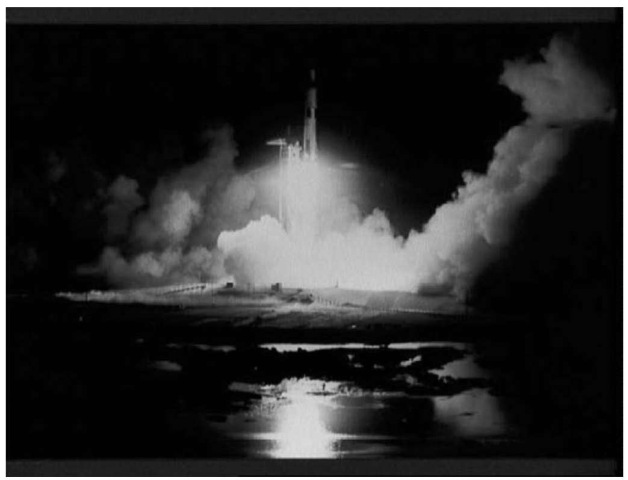
Figure 1. Night launch of the Saturn V rocket carrying the Apollo 17 Mission to the Moon at 12:40 a.m., 7 December 1972 (courtesy of NASA).
The Apollo 17 Mission
The Valley of Taurus-Littrow (Fig. 2) offered four major benefits as the last Apollo landing site, taken in the context of a final test of then current hypotheses related to the origin and evolution of the Moon. First, photogeologic analysis indicated that Taurus-Littrow provided access to a three-dimensional window into a mountain ring created by the Serenitatis large basin-forming event, by now well established as the result of a giant impact of an asteroid or comet. Second, major units of mare basalt and older nonmare rocks would be within easy reach of roving vehicle traverses. Third, a mantle of dark, possibly young volcanic debris partially covered the region as well as portions of the valley, and craters of a range of depths penetrated this debris and the underlying basalt. And, fourth, the valley lies about 600-km north and 200-km east of the Apollo 11 and Apollo 15 sample areas, respectively, adding significantly to our exploration coverage of the Moon’s nearside.
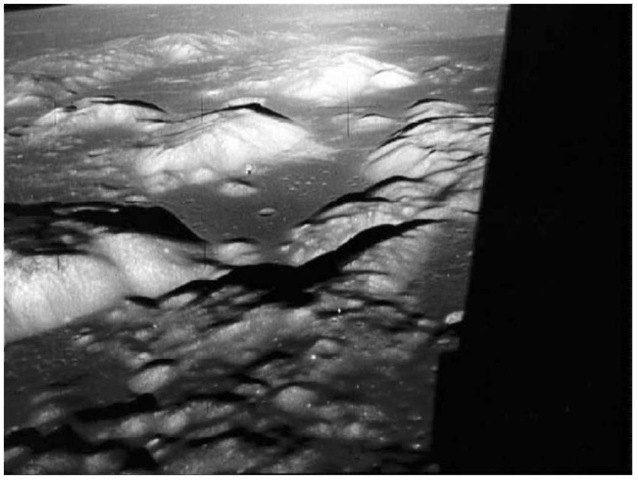
Figure 2. The Valley of Taurus-Littrow as seen from the Commander’s window on the left side of the Lunar Module Challenger on the orbit of the Moon before landing. The view is approximately west northwest, looking toward the Serenitatis Basin.
The Lunar Module crew of Apollo 17, Commander Eugene A. Cernan, and the writer as geologist and Lunar Module Pilot, conducted 22 hours of field exploration and experiment deployment in the Valley of Taurus-Littrow between 11 and 14 December 1972. During this period, the crew investigated, photographed, and sampled 11 major field locations. We traversed, observed, and sampled more than 35-km of the valley floor and obtained and documented 120-kg of samples from 97 major boulders and 75 other lunar materials. We took 2200 documentation photographs and deployed the 11 experiments of the Advanced Lunar Science Experiment Package (10). The crew had trained together for 15 months before launch, several days a month consisted of simulated traverses at field sites illustrating one or more of the types of geologic problems expected on the Moon and specifically at Taurus-Littrow. Combined with the geologic experience of the author, the organization and flexibility of the exploration plans (11-13), and the close cooperation of the science team in direct support on Earth, this training gave a stronger scientific foundation to Apollo 17′s exploration that had been possible during previous Apollo missions (14,15).
The North and South Massifs constitute the major structural boundaries of the Valley of Taurus-Littrow. Slopes of an approximately constant 25° flank the Massifs, rising 2000 and 2300 m, respectively, above the valley floor. Discontinuous, but roughly horizontal exposures of thick sections of crustal rocks that predate the major mare basalt eruptions exist on the steepest upper slopes. These outcrops or near outcrops create numerous fields of exposed rock from which tracks lead downward to some of the sampled boulders at the base of the Massifs. Interlocking domes called the Sculptured Hills constitute Taurus-Litt-row’s northeastern wall and have concentrations of boulders apparent only on the inaccessible upper slopes of these hills. The valley floor consists of an undulating, highly cratered, relatively flat surface, covered largely by broken and pulverized basalt. One group of the cluster of craters surrounding the spot where Challenger landed, lies on a ray of secondary ejecta from the crater Tycho (16) 2000-km to the southwest. The largest of these craters is about 600-m in diameter. An older cluster of craters of about the same range of sizes cut into the floor northeast and to the west of the landing point, near the base of the North Massif. An irregular fan of material, the light mantle, projects northeast from the base of the South Massif. Finger-like projections of this fan reach out as much as 6-km from the Massif. Premission photographs suggested that a mantle of dark material covers the valley as a whole, including portions of the surrounding mountains. All surfaces are composed as pulverized debris called “regolith” (17), consisting largely of fragments of the bedrock below mixed with dark mantling material and other materials thrown into the area by more distant meteor impacts or introduced by volcanic eruptions younger than the bedrock.
Scientific activities in Taurus-Littrow (Fig. 3) began with the deployment of the experiments constituting the sixth and final Apollo Lunar Surface Experiments Package (ALSEP). This package had been enhanced to have a design life of 2 years rather than one (18). In connection with drilling holes for the heat flow experiment, two cores through the upper 3.2-m of the central valley regolith were obtained. Despite minor interruptions to work on technical problems with the ALSEP, about a third of the first excursion (extravehicular activity or EVA) and most of the second and third excursions concentrated on the planned traverses and exploration. Actual traverses followed this plan closely (19-22) except for a curtailed first traverse that only reached a point on the rim of Steno crater rather than reaching the original objective of Powell and deletion of the third traverse’s Station 10 at Sherlock. Investigations of the basaltic mare materials south of the landing point began on the first excursion. On the second day, the traverse went west to sample premare materials at the base of the South Massif (Station 2). We then worked back over the light mantle deposit (Stations 2A and 3); to the dark, possibly volcanic crater, Shorty (Station 4); over the contact between light mantle and mare; and finally into the basalt boulder field surrounding the 100-150 m deep crater, Camelot (Station 5). The third day started with a long study of large boulders at the base of the North Massif (Stations 6 and 7), followed by sampling in the regolith at the base of the Sculptured Hills (Station 8), and a final stop at another possible volcanic crater, Van Serg (Station 9). Along each lunar rover traverse, we periodically sampled the surface of the regolith across various geologic units, deployed explosive charges for the active seismic profiling experiment, monitored the receiver for the surface electrical properties experiment,and obtained readings from the traverse gravimeter (23). The principal sampling tools used included a rock hammer, a pair of long handled tongs, 35 and 70 cm core tubes, a long handled scoop (also used for trenching), and a supply of pre-numbered Teflon sample bags (Fig. 4).
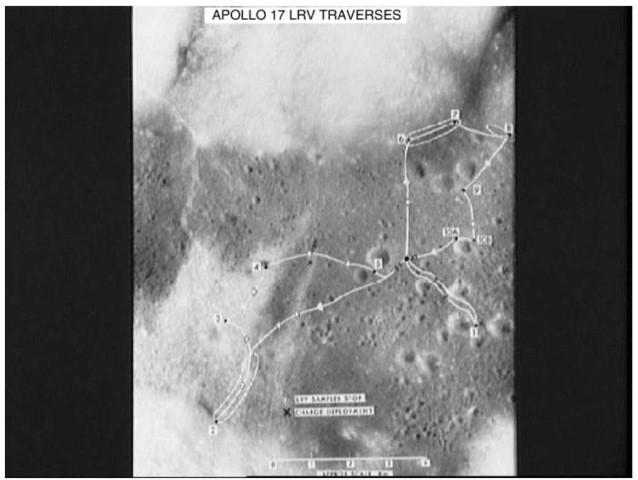
Figure 3. Apollo 17 exploration area in the Valley of Taurus-Littrow showing the landing site, exploration stations (numbers), and general traverses.
Impact Cratering
Almost everything we think we know about to the Moon must be viewed through the filter of impact cratering effects (Fig. 5) that have dominated lunar history from its origin to the present (24-29). The impact of comets, asteroids, meteors, micrometeors, dust, and energetic atomic and nuclear particles have modified the surface and near-surface expression of all of the internally generated processes that contributed to the present physical nature of the Moon. The secondary effects of each impact have magnified the importance of these impacts. Most comet, asteroid, meteor, and micrometeoroid impact velocities are between 13 and 18-km/s, and some are as high as 70-km/s, giving target pressures at the point of impact of several hundred Gpa (gigapascal). Extraordinary amounts of heat per unit mass are released as conversion of kinetic energy into forward and rearward shock waves takes place almost instantaneously. The amount of ex-tralunar material that can be identified in regolith samples returned to Earth indicates that about 98% (30) to 99.7% (31) of all but the larger projectiles is melted, vaporized, or ionized, and returned to space. The general characteristics of lunar impact craters as a function of diameter are summarized in Table 1.
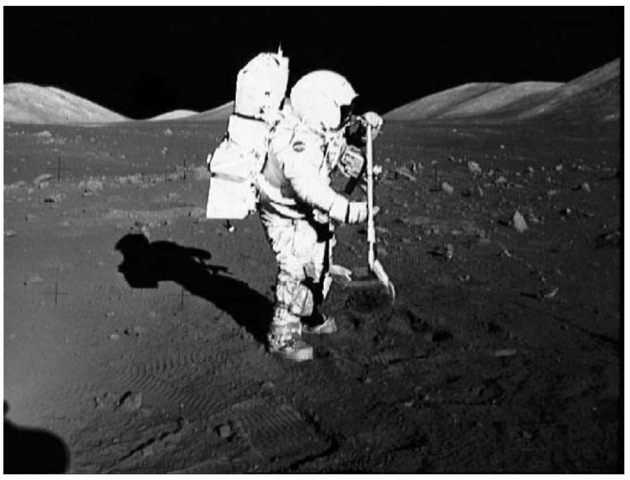
Figure 4. The author as a well-equipped astronaut on the Moon during the Apollo 17 mission in the Valley of Taurus-Littrow. He is using ”the rake” sampling device to sift rock fragments from the finer portions of the regolith and has a 70-mm Hasselblad camera mounted on his chest.
Processes associated with cratering and space radiation have created a well-defined zone of debris that covers essentially the entire Moon; its thickness depends on the length of exposure of a specific geologic unit or feature. This zone is called the ”regolith,” a terrestrial term also used for the Moon. Essentially all the samples returned from the Moon by Apollo have come from the regolith or from rocks incorporated within it. It has been defined as ”the layer or mantle of fragmental and unconsolidated rock material, whether residual or transported and of highly varied character, that nearly everywhere forms the surface of the land and overlies or covers bedrock. It includes rock debris of all kinds, including volcanic ashy lunar regolith consists [largely] of particles <1-cm in size although larger cobbles and boulders, some as much as several meters across, are commonly found____much of the pulverized material is melted and welded together to produce breccias (fragmental rocks) and impact melt rocks, which make up a significant portion of the regolith… ”(32,33). A particularly important part of the lunar regolith consists of aggregates of rock, mineral, and glass fragments,called agglutinates, held together by impact melt glass. Recently, it has been shown that on the nanometer scale, iron metal particles accreted on and formed in the rims of regolith grains significantly affect optical and magnetic properties (34-36). Further, the lunar regolith contains embedded solar wind gases, mete-oritic material, and isotopic products and crystal structure damage produced by solar and cosmic radiation. The average depth of the regolith in a given area reflects the age of the underlying bedrock. Lateral mixing of material derived from adjoining bedrock units is a function of the age of the separating contact.
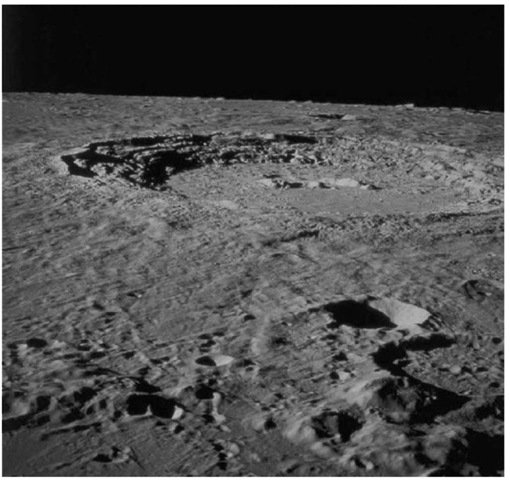
Figure 5. The 95-km diameter impact crater Copernicus as seen from the Apollo 17 Lunar Module Challenger after its departure from the Moon on 14 December 1972. Data from the Apollo 12 mission indicate that Copernicus formed about 900 m.y. ago.
Origin and Evolution
A “standard” or “conventional” hypothesis for the origin and evolution of the Moon evolved significantly during the last three decades of the twentieth century. This hypothesis currently holds that the Moon formed about 4.57 billion years (b.y.) ago by the aggregation of material produced during a giant impact between the very young Earth and a Mars-sized asteroid; most metallic core-forming material remained with Earth (37-43). Such an origin could explain the high angular momentum of the Earth-Moon system and at least some of the lunar geochemical constraints related to iron, volatile, and alkali elements other than potassium (44). Soon after or during lunar aggregation, lunar core formation occurred (45,46), and a Magma Ocean developed on its surface (47,48). The lunar Magma Ocean largely crystallized within 50 million years (m.y.) of the creation of the solar nebula and, at the same time, differentiated due to contrasts in mineral densities into an olivine-pyroxene dominated mantle and a 60-70-km thick Caplagioclase-rich crust (49,50). Late in this differentiation process, potassium, rare-earth elements, phosphorous, and thorium-rich residual liquid (urKREEP) (51) accumulated beneath the crust, largely in the region beneath what is now the Procellarum basin (52-56). Late ilmenite-rich cumulates (57) sank toward the base of the less dense olivine and pyroxene cumulates carrying some urKREEP material with them (58). Intrusive and extrusive basaltic magmatic activity began soon after the Magma Ocean crystallized and, before the main sequence of mare basalt eruption began at about 3.8 b.y., produced the magnesium-rich suite of plutonic rocks (Mg-suite) (59-61), KREEP-rich basalts (62), and the cryptomaria (63-66). At about 3.85b.y., a concentrated bombardment of the crust took place that produced most or all of the ~ 50 basins greater than 300-km in diameter visible today as well as most other observed cratering effects in the lunar crust (67-71). The effect of this late lunar “cataclysm” was to reset the ages of all crustal impact glasses yet studied (72,73). South Pole-Aitken basin is probably the only basin > 1000-km in diameter to form during this late bombardment (74); the Procellarum basin is an artifact of the superposition of several smaller basins (75). A global magnetic field and presumably a circulating fluid metallic core were present at least between 3.9 and 3.8b.y. (76-78). The core is now between 300 and 400-km in radius (79-81). Between 3.9b.y. and about 1.0b.y., mare basalts and basaltic pyroclastic materials erupted, largely on the nearside of the Moon (82-84). Major features on the Moon have been little modified subsequently other than the development of several meters of impact-generated regolith on most surfaces (85).
Table 1. General Characteristics of Lunar Craters as a Function of Size*
| Diameter range | General characteristics |
| examples | |
| <10-m | • Craters norm ally do not penetrate the regolith. |
| • Depth to diameter ratio variable. | |
| • Glass discontinuously lines shallow pits in the center of fresh | |
| craters. | |
| * Mineral grains shattered around small craters on solid rock (zap | |
| pits). | |
| * Deep pits (~1/3 the crater diameter) in the center of some | |
| craters. | |
| ~10-m to -100-m | * Craters normally penetrate mare regolith if above 20-m |
| Van Serg and | diameter. |
| Shorty Craters in | * Depth to diameter ratio about 1:3 to 1:4 for fresh craters. |
| Taurus-Littrow | * Inner benches common if target material stratified. |
| * Regolith breccias present inside and on the ejecta blankets of | |
| young craters. | |
| * Ejecta blankets extend to about one crater diameter. | |
| * Target strata are overturned, but original vertical sequence is | |
| preserved in ejecta blanket. | |
| b 100-m to ~10-km | * Both transient and initial steady-state craters are |
| Taruntius; | hemispherical and have circular and raised rims. |
| Camelot Crater in | * Depth to diameter ratio about 1:3 to 1:4 for fresh craters. |
| Taurus-Littrow | * Impact breccias present inside and on the ejecta blankets of |
| young craters. | |
| * Ejecta blankets extend to about one crater diameter. | |
| * Secondary impact cratering significantly modifies surface | |
| features out to many crater diameters from the edge of | |
| continuous ejecta. | |
| * Target strata are overturned, but their original vertical | |
| sequence is preserved in ejecta blanket. | |
| ~10-km to <300-km | * Transient crater approaches hemisphere and has a circular |
| Copernicus | raised rim and probably is lined with a shell of impact melt. |
| * Initial steady-state crater has a flat floor and central mound or | |
| peak. | |
| * Initial steady-state crater walls have many stepwise benches | |
| (slump landslides) on walls. | |
| * Hummocky crater floors and the depressions on wall benches | |
| and near-rim ejecta blankets of larger craters have indications | |
| of pools and flows of impact melt. | |
| * Ejecta blankets extend to about one crater diameter. | |
| * Target strata are overturned, but their original vertical | |
| sequence is preserved in ejecta blanket. | |
| * Secondary impact craters, crater clusters, crater chains, and | |
| herringbone crater chains extend several thousand kilometers | |
| beyond edge of continuous ejecta. |
Table 1. (Continued)
| Diameter range | General characteristics |
| examples | |
| >300-km (basin) | • Transient crater depth to diameter ratio decreases with |
| Orientale | increasing size as lithostatic pressures compete with explosive |
| pressures. | |
| * Transient crater has an increasingly flat trapezoidal | |
| crosssection and increasing diameters. | |
| * Transient crater has a flat floor, a circular raised rim, and | |
| probably is lined with a thick shell of impact melt. | |
| * Initial steady-state crater has a fractured, flat floor and central | |
| ring or partial ring of peaks. | |
| * Initial steady-state crater walls have many wide, stepwise | |
| benches (slump landslides) on walls. | |
| * Floors and depressions on wall benches and near-rim ejecta | |
| blankets have indications of large pools, mantles, and flows of | |
| impact melt. Impact melt also injected into target materials. | |
| * Ejecta and debris flow blankets extend beyond one crater | |
| diameter. | |
| * Two to six rings of mountains outside transient crater rim | |
| around basins > 400-km in diameter. | |
| * Target strata sequence is not well preserved in ejecta blanket | |
| due to extensive mixing of ejecta during flow. | |
| * Within one crater diameter of the final steady-state rim, there is | |
| a continuous deposit of melt breccia, possibly several hundred | |
| meters thick at the rim of the larger basins. | |
| * Secondary impact craters, crater clusters, crater chains, and | |
| herringbone crater chains extend beyond the edge of continuous | |
| ejecta and debris flows and reach thousands of kilometers and | |
| probably around the entire Moon to the basin antipode. |
Although some aspects of this conventional hypothesis of lunar origin and evolution are attractive and probably correct, as will be discussed throughout this article, numerous difficulties exist in reconciling a number of its implications with everything we think we know about the Moon (86-89). Some of the major questions that can be raised with the conventional hypothesis are as follows:
1. Was the Moon formed as a result of a giant impact on Earth immediately after Earth’s accretion or was it formed independently and later captured?
2. Did core formation in the Moon and other terrestrial planets occur immediately after their accretion or was it delayed by the existence of a silicate protocore?
3. Did thermal convection and/or impact-induced splash cooling play a significant role in the crystallization and differentiation of the Magma Ocean?
4. Did the Moon’s Magma Ocean’s late ilmenite-rich cumulate sink near the base of the cumulate pile globally or only in response to local destabilization by the formation of a few extremely large impact basins?
5. Was the Moon’s Magma Ocean’s residual liquid (urKREEP) initially concentrated beneath the Procellarum Basin or distributed in a spherically uniform shell under the lunar crust?
6. Was the global thermal insulation effect of the impact-generated megar-egolith of the lunar highlands critical to the later formation of the magmas that formed the basaltic maria?
7. Is the Procellarum Basin a consequence of the merging of several smaller basins or of a single extremely large impact?
8. Were the one or more extremely large impact basins and the ~50 large basins on the Moon the result of a ”cataclysm” of impacts at about 3.85 b.y. or of a sustained bombardment lasting about 400 m.y.?
9. Was melting of the mantle due to pressure release (90) after large basin events significant in generating of magmas related to the Mg-suite of lunar rocks?
The scientific results of the Apollo 17 mission can now be viewed in the context of the conventional hypothesis and questions about that hypothesis from the perspective of more than 40 years of modern study of all of the Apollo missions and other lunar investigations. These later investigations have included telescopic and photogeologic mapping of the lunar surface, Apollo sample analyses, automated missions that both preceded (91) and followed Apollo, and the remarkable thought and computer modeling that has been stimulated by the collected data. Broadened multidisciplinary discussions of lunar origin and evolution are assisted by a descriptive formulation of the formative stages of lunar evolution as an augmentation of the traditional time-stratigraphic approach (92). The term “stage” is not used below in the normal time-stratigraphic sense (93). Rather “stage” is used in a more general sense for overlapping periods of lunar history that have definable but somewhat arbitrary beginnings and endings due in large part to the current incompleteness of information about the absolute ages of lunar events. Thus, the evolution of the Moon as a small planet (94-98) can be descriptively summarized as follows (Plate 1):
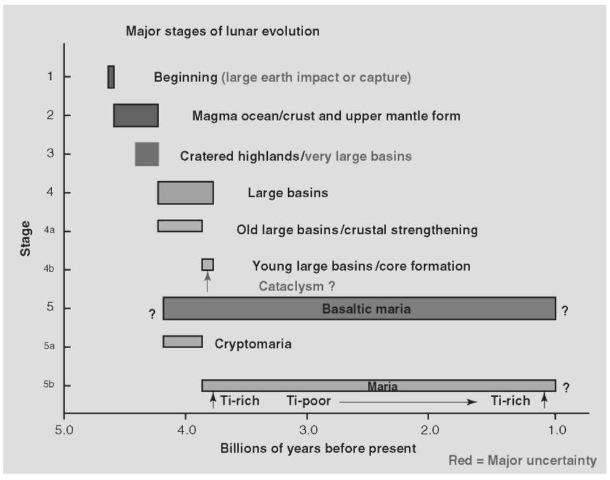
Plate 1. Major stages of lunar evolution.
Stage 1: Beginning [Pre-Nectarian (99)]—4.57b.y. before present Stage 2: Magma Ocean (Pre-Nectarian)—4.57-~4.2(?) b.y. Stage 3: Cratered Highlands/Very Large Basins (Pre-Nectarian)—~ 4.4-~4.2(?) b.y.
Stage 4: Large Basins—(Pre-Nectarian-Upper Imbrium)—~4.2(?)-3.8b.y. Stage 4A: Old Large Basins/Crustal Strengthening (Pre-Nectarian)— ~4.2(?)-3.92b.y.
Stage 4B: Young Large Basins (Nectarian-Lower Imbrium)—3.92-3.80b.y.
Stage 5: Basaltic Maria (Pre-Nectarian-Copernican?)—~4.2(?)-1.0(?) b.y.
Stage 5A: Cryptomaria (Pre-Nectarian)— ~4.2(?)-3.92b.y.
Stage 5B: Maria (Upper Imbrium-Copernican?)—~3.9-1.0(?) b.y. Stage 6: Mature Surface (Pre-Nectarian-Copernican)—~ 3.9 b.y.-Present.
Each of these formative stages overlapped significantly. The Magma Ocean began to form before the end of lunar accretion and probably was not fully solidified until after the end of the formation of old large basins. The Cratered Highlands overlapped at least the beginning of the Large Basin Stage. The Basaltic Maria magmas probably began forming initially by pressure-release (decompression) melting and then by thermal remelting of the upper mantle. Basaltic maria lavas first appeared on the lunar surface during the Large Basin Stage as cryptomaria and then partially filled many later large basins and other depressions. The regolith that underlies mature surfaces began forming on exposed units at the beginning of the Cratered Highlands Stage and continues to form today. Graphical cartoons illustrating this formulation of lunar evolution are referred to by Plate number in the following discussion. Beginning (Stage 1). Discussion of the origin of the Moon (Plates 2 and 3) includes issues related to the origin of Earth and also to the origin of the solar system as well (100,101). One of the few undisputed scientific conclusions about the solar system as a whole is that it was formed from a concentration of interstellar dust and gas 4.567 b.y. ago. This conclusion is inferred from the radiometric ages of chondritic, eucritic, and iron meteorites (102-104) and from the initial isotopic ratios (radiometric model ages) of many lunar samples (105). Meteorites and lunar samples also preserve a record of extinct radionuclides. This record is consistent with the hypothesis that the formation of our solar system was initiated by an interstellar shock wave generated by a nearby supernova (106-108) that contributed the now extinct radionuclides and other materials to the solar nebula. The chemical similarity of carbonaceous chondrite (CI) meteorites to the composition of the Sun (109) and the current apparent abundance of such material in the solar system have led to the assumption that these meteorites closely represent the composition of primordial material that formed the Sun and the terrestrial planets. Computer models of processes in the early nebula have cast some light on what may have been happening after the shock wave during the first 10 million years or so (110-112). Once the initial angular momentum of the collapsing interstellar cloud had been dissipated and the rotating disk of the solar nebula had formed around the young Sun, particles began to stick together. This led gradually to the formation of planetesimals and then more rapidly to the formation of planets. The relationship at this point between Earth and the Moon, if the Moon existed, remains unknown. Refractory element ratios (113,114) and oxygen isotope ratios (115-119) indicate, within the limits of analytical error, that the materials which accreted to form the two bodies came from the same accre-tionary region (feeding zone) of the solar nebula.
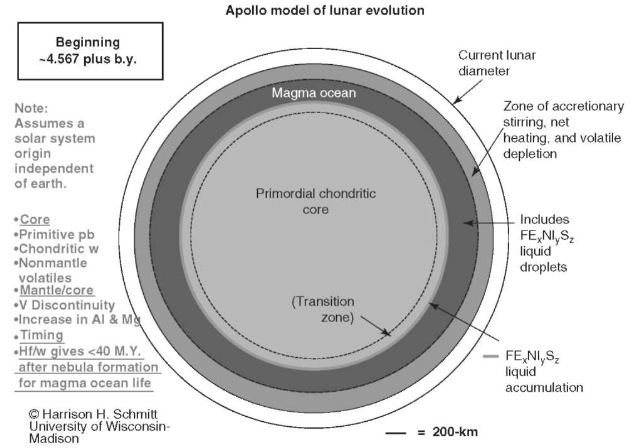
Plate 2. Apollo model of lunar evolution—Beginning ~4.567 plus b.y.
After the initial analysis of the results of the Apollo landings and subsequent robotic missions was completed, the question of the origin of the Moon boiled down to two competing hypotheses. As discussed before, a majority of present workers favors formation of the Moon as a result of the impact of a differentiated ”Mars-sized asteroid” with a young but at least partially differentiated Earth. General computer modeling of such an origin suggests that it may explain the unusually high angular momentum of the Earth-Moon system (120,121). On the other hand, the amount of iron in the Moon (12%) in comparison to just Earth’s mantle (8%) appears to require that 90% or more of the Moon, formed in this ”giant impact” model, must come from the impactor and relatively little from Earth’s mantle (122). A similar conclusion can be drawn from consideration of Hf/W systematics for Earth and the Moon (123). Thus, the giant impact model represents more of a Moon formed by impact-assisted capture of the mantle of the impactor rather than including a measurable fraction of the mantle of Earth. Increasingly, some of the geochemical inconsistencies of this computer model, particularly the evidence of an undifferentiated lower mantle discussed below, are being recognized (124-126). Other workers previously have suggested that the evidence supports the capture of the Moon by Earth after both formed independently as planets (127,128). In addition, models of giant impact scenarios are becoming increasingly confining in their possible initial conditions and subsequent evolutionary paths before the existing Earth-Moon system could have been created (129-136). Capture, provided that it is found compatible with the constraints of angular momentum, appears to be better than a giant impact in explaining the geochemical and geophysical structure of the lower mantle of the Moon. It has been suggested qualitatively, however, that special conditions related to a giant impact could produce the apparent undifferentiated characteristics of the lower lunar mantle (137,138). Considerations of lunar accretion from a circumterrestrial disk (139) also should receive additional attention in modeling studies (140).
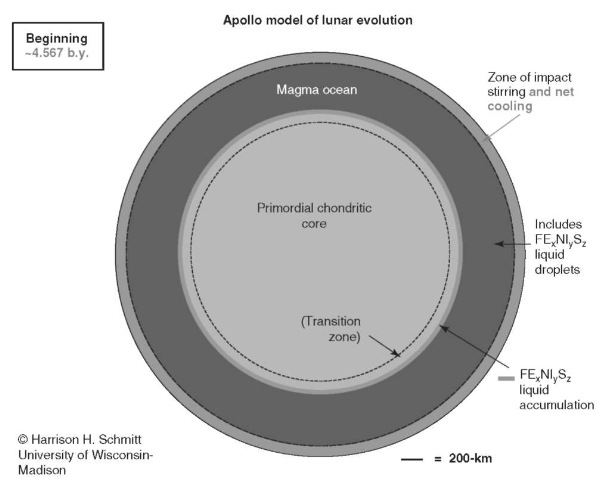
Plate 3. Apollo model of lunar evolution—Beginning ~ 4.567 b.y.
No modern modeling studies of the capture hypothesis have been conducted since the early 1970s. Capture options, however, may exist that can explain the high angular momentum of the Earth-Moon system (141). Inherent in the capture hypothesis is the assumption that the Moon accreted in the inner solar system simultaneously with Earth, beginning with a cool, chondritic protocore upon which a Magma Ocean developed as the accumulated energy of accreting material increased with time. Gaining an early slight advantage in mass, coor-biting Earth would have grown more rapidly and attracted proportionally more of the heavy element-rich planetesimals than the Moon, drawing from the same radial mixing orbital reservoir (142) in the solar nebula. The relatively devolatilized character of the outer portions of the Moon, of which the Apollo samples are representative, would result from a much less competitive lunar gravity well relative to that of Earth both during accretion and during the impact-enhanced devolatilization of the lunar Magma Ocean. Alkali element depletions and isotopic ratios calculated for the Moon do not require the extreme devolatilization of a giant impact (143). Laboratory studies suggest that the volatility of sodium from a Magma Ocean is too low to account for the present proportion of sodium in the Moon (144). These studies, however, have not taken into account the pervasive stirring and spot high temperatures due to impacts that would enhance the efficiency of devolatilization of relatively volatile elements. Impact-generated temperatures of several thousand degrees would have existed locally near each impact point (145,146) and may have prevailed throughout the upper portions of the Magma Ocean during the last phases of extremely rapid lunar accretion. These portions of the Magma Ocean could be said to be boiling! Limits to devolatilization are indicated by the lack of frac-tionation between stable potassium and magnesium isotopes in the Moon; iso-topic ratios of these elements are the same as Earth’s (147,148). This lack of alkali isotopic fractionation and a rubidium/cesium ratio only a factor of about 2 greater than carbonaeous chondrites (149) indicate that the temperature of the impact-stirred portion of the upper Magma Ocean (although potentially several thousand degrees C) did not exceed that required for complete vaporization of alkali components. The reduced state of the Moon (150,151) also may relate to devolatilization of the Magma Ocean during which the ratio of water to iron was decreased to the point where all remaining water was disassociated by reaction with immiscible iron-rich liquid separating from the Magma Ocean.
The geochemical constraints of the lower mantle (below about 550 km), indicated by analyses of lunar pyroclastic glasses, also support the capture hypothesis. Volatiles and isotopic systems in the pyroclastic glasses that indicate largely undifferentiated source regions in the lower lunar mantle are incompatible with a Moon formed from the differentiated mantles of two impacting bodies, as required by the giant impact hypothesis of origin. Data from the Apollo 17 deposit of orange pyroclastic volcanic glasses have contributed significantly to this continuing debate over the origin of the Moon. The discovery of orange volcanic glass (”orange soil”) in the rim of Shorty Crater (Station 4) and close to its original point of deposition (152), subsequent recognition of volcanic glasses as a widespread component of the lunar regolith, and detailed examination of these glasses in terrestrial laboratories established a number of new geochemical constraints on the origin of the Moon (153-155). Finding the orange glass (Figs. 6 and 7), whose geology is discussed under the Basaltic Maria Stage below, came from the convergence of a number of factors. First, one of the primary objectives of the mission to Taurus-Littrow was to search for the cause of dark mantling, possibly pyroclastic (explosive) volcanic deposits in the region. Second, premission consideration of multiple hypotheses for the origin of the dark-halo crater called Shorty included the possibility that it might be a volcanic vent, even though all evidence then available pointed to an impact origin. Finally, the writer’s experience in volcanic provinces on Earth and his normal field geologist’s instincts to watch one’s feet probably were important factors. From the moment of discovery (156,157), it was clear that the orange glass would be significant, but how significant was not known until its return to Earth. It took detailed investigations in terrestrial laboratories before the ramifications of the glass slowly became clear. The primary importance of the pyroclastic glasses relative to lunar origin lies in the composition of the adsorbed volatiles on the surfaces of the small glass beads, and devitrified glass beads, as distinct from the glass itself. The volatiles washed from the surfaces of the beads are unlike any other lunar materials yet analyzed (158,159). A similar volatile component exists in the green volcanic glasses sampled by Apollo 15. Volatiles associated with both types of glasses are enriched over associated basalts by factors > 100 in Cl, F, Br, Zn, Ge, Sc, Tl, and Ag and by factors > 10 in Pb, Ga, Sb, Bi, In, Au, Ni, Se, Te, and Cu. These anomalies suggest that volatile components, otherwise depleted in lunar samples, are present in significantly higher abundances in the source areas of the volatiles accompanying pyroclastic glasses (160,161). The isotopic composition of the lead associated with the orange glass provides an even more unusual data point. It is isotopically primitive (162-166), that is, the lead had not been separated from its uranium and thorium radiogenic sources before eruption at the surface. Similarly, there is a chondritic initial tungsten value for the combined volatile and glass components, again suggesting that the lower mantle is largely undifferentiated and close to chondritic in composition (167).

Figure 6. View of the Station 4 area, the site of the orange volcanic glass on the southern rim of the 110-m diameter Shorty Crater (to the right). The orange glass deposit lies just this side of the large boulder on the rim of Shorty, behind and to the right of the lunar roving vehicle and the author (courtesy of NASA).
Thus, the data related to volcanic glasses indicate that the source of the volatile components of the Apollo 17 orange glass lies below the devolatilized and differentiated cumulates of the Magma Ocean (see below) in a relatively undifferentiated, possibly largely chondritic lower mantle. New assessments of Apollo seismic data suggest that the transition between the upper and lower mantle exists at about 550 km (168,169). A largely undifferentiated lower mantle does not fit the current model of lunar origin from debris generated by the impact of a differentiated planetesimal on a differentiated Earth. That debris would have lost much of its chondritic character prior to lunar accretion (170-172). Additionally, unlike Earth, the hafnium-tungsten isotopic system has significant variations within various categories of lunar samples (173,174) as a consequence of internal differentiation of these elements during the Magma Ocean Stage of lunar evolution (175). The mean model age (176) for the now extinct 182Hf (half-life = 9m.y.) and its stable daughter 182W is about 50m.y. in samples directly or indirectly related to the differentiation of the majority of the lunar Magma Ocean (177). The orange glass isochron (178) also indicates an age of 54 7 7.5 m.y. (179). These data are consistent with the idea that most of the Magma Ocean crystallized in 50m.y. or less (180) and with theoretical analyses that Magma Oceans existed on terrestrial planets only very early in the history of the solar system (181).
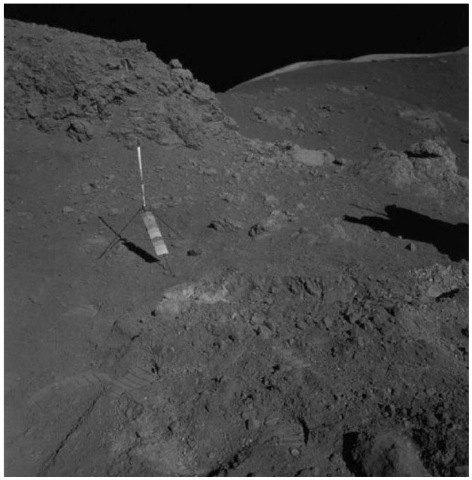
Figure 7. The Station 4 sample locality for the Apollo 17 orange volcanic glass, showing the dark, reddish orange central zone of the deposit and light-colored altered regolith at the left-hand contact.
Dynamical modeling and extinct isotope data (182,183) indicate that both accretion and planetary differentiation took place rapidly. A ~ 50 m.y. model age for forming major portions of the lunar mantle creates a very narrow, but not closed, window for a Mars-sized planetesimal and Earth to interact to form the Moon, considering that the total detectable life of 182Hf would be ~ 90 m.y. Thus, within the first ~ 40 m.y. of 182Hf’s existence, the following must occur:
1. The supernova that created 182Hf and other now extinct isotopes must interact with and trigger the collapse of the interstellar gas and dust cloud to form the solar nebula.
2. Angular momentum within the solar nebula must be dissipated.
3. Planetesimals that have chondritic proto-cores must form in the inner solar nebula and aggregate into the terrestrial planets.
4. Magma oceans must form on some or all the terrestrial planets and be sufficiently stable that FexNiySz liquid can separate and accumulate at the base of the magma oceans.
5. Magma oceans must cool to a temperature where silicate crystallization and differentiation can begin.
6. FexNiySz metallic cores must displace the chondritic protocores of Earth and the impacting Mars-sized planetesimal if the Moon is to result from their impact interaction.
7. Sufficient silicate cumulates must form in the lunar magma ocean to isolate that portion of the Hf/W system in the source region of future mare basalts from the residual Magma Ocean.
Because steps 1-4 probably took 20-100 m.y. (184,185), then Hf/W system-atics indicate that the formation of the Moon by a giant impact of another planet on the Earth must have occurred within a very narrow window of time—the first 30 m.y. or less. In spite of the narrowness of the opportunity, current modeling suggests that this is the most likely period for a giant impact to have occurred in the inner solar system (186,187). If such interaction did occur in this window and magma oceans existed on both objects at the time of impact (188), metallic core formation and initial mantle differentiation would have been incomplete. This would be inconsistent with what is known about the chemistry of the Moon and would require subsequent large accretionary impacts to adjust that chemistry to what is observed (189). Additionally, as discussed above, the apparent 182Hf/182W isochron age for the orange volcanic glass and its volatile component is 54 7 7.5 m.y. This suggests that the deep source regions for the volatiles associated with the orange glass became closed systems for Hf and W when the volatiles’ source areas in the more primitive lower mantle were no longer exposed to downwardly migrating FexNiySz liquid (see Magma Ocean discussion below).
Such migration would have kept the system temporarily open relative to tungsten. Thus, until the giant impact model for lunar origin or even an impact-assisted capture model or a circumterrestrial disk model can accommodate these geochemical and geophysical constraints, none of these models represent reality. At this time, the writer favors an origin by relatively passive Earth capture (190); however, most workers in lunar science favor origin by giant impact. No evidence has been recognized that would suggest when capture might have occurred; however, apparent lunar tidal signatures in 2.0 b.y. (191) and 3.2 b.y. (192) old terrestrial sedimentary rocks indicate a lunar influence on Earth’s oceans by at least that time. The 3.2 b.y. tidal signature also has been interpreted to indicate that the lunar orbital shape at that point was similar to the current shape. If tidal interaction between Earth and the Moon’s iron-rich core were necessary to produce a dynamo-generated lunar magnetic field (193), then the Moon had been captured by ~ 3.85 b.y. ago. This is the age of the large impact basin Imbrium (194), the oldest large basin that has a clearly identified remnant magnetic field (195) antipodal to it.
Magma Ocean (Stage 2). A consensus has developed from the data from all of the Apollo missions that, as accretion of the Moon accelerated, a silicate Magma Ocean was created (196-201) (Plate 2). Although debate continues as to the depth of the lunar Magma Ocean, the geophysical constraints (202-204) appear to indicate that only the outer ~500-km melted, another 50-100-km partially melted, and a ”primitive accretion core” (205), of roughly 1200-km radius, remained relatively cool and solid. Melting of the accreting material was accomplished by the conversion of accretionary kinetic and potential energy to heat and by the decay of short-lived radioisotopes such as aluminum-26 (206). As the Magma Ocean formed, the dynamic heating, splashing, and stirring of the global melt would have delayed differentiation (relative separation of the elements) due to fractional crystallization, a process by which minerals more dense and less dense than the parent melt sink or float, respectively, as they crystallize. As discussed before, some volatile differentiation, due to the thermal escape of elements too light and thermally energetic to be held by lunar gravity, would occur during this formative period, provided that the temperature of the Magma Ocean exposed to space reached several thousand degrees C. Thus, water, carbon dioxide, nitrogen, noble gases, and highly volatile elements, such as bismuth (Bi), thallium (Tl), indium (In), and cadmium (Cd) (207), are strongly depleted in the outer Moon relative to solar and carbonaceous chondritic abundances (208). Moderately volatile elements, such as lithium (Li), sodium (Na), potasium (K), rubidium (Rb), and cesium (Cs), are somewhat depleted as well (209). Sodium is depleted by a factor of 3-5 compared to Earth (210). The rare-earth elements, however, do not show evidence of selective loss based on their range of volatility (211). This suggests that at least some of the apparent elemental depletion patterns in lunar materials were inherited from the materials from which it was formed (212,213), either the differentiated mantle of a large impactor (giant impact), a circumterrestrial postaccretion disk, or differentiated planetesimals elsewhere in the inner solar system (capture). Also, as the materials from which the Moon formed probably consisted of largely oxidized phases that had chondri-tic affinities, initial separation of liquid metallic iron may not have occurred in the early Magma Ocean. Rather, as accreting material began to melt, iron and nickel, along with sulfur, would be concentrated in an immiscible (214) metal-rich liquid (FexNiySz) (215,216) accompanied by some portion of other side-rophilic elements (217), including cobalt, precious metals, and platinum group elements (PGE). The actual cobalt and nickel contents for the Moon as a whole and for the lunar mantle in particular are still uncertain (218,219) and cannot yet be relied upon to help unravel the question of lunar origin. An iron and sulfur-rich liquid would have been an immiscible in the predominantly silicate liquid of the Magma Ocean. As iron-rich liquids are very dense, >4.5-gm/cm3,a rain of small droplets would aggregate rapidly on the floor of the Magma Ocean (density ~3.3-gm/cm3) and ultimately move toward the center of the Moon through the cooler lower mantle. In the process of nucleation in the Magma Ocean, the immiscible FexNiySz droplets would react with any remaining water to form hydrogen and iron oxide (wustite). Hydrogen would be dissolved in the silicate liquid, maintaining a reducing environment in the Magma Ocean early in its differentiation history. That this occurred is consistent with the necessarily reduced state of europium ions in the Magma Ocean during differentiation (220) and with experimental work (221) relative to chromium abundances in volcanic glasses. Both facts indicate low oxygen fugacities (measures of the tendency toward oxidation) in the Magma Ocean.
The next major change in the Magma Ocean began with the sequential crystallization of silicate minerals (222-224) and their separation from the liquid in relation to contrasting densities, that is, fractional crystallization (Plate 4). This critical chemical differentiation process started when the rate of heat addition due to accretion and radioactive decay became less than the rate of heat loss, and the temperature of at least portions of the Magma Ocean decreased to about 1300°C. Minerals forming in a silicate liquid have compositions different from that liquid, so chemical change in the liquid, that is, differentiation, results when those minerals are separated from the liquid. Assuming that the composition of the Magma Ocean resembled an iron, nickel, sulfur, and volatile-depleted carbonaceous chondrite, the first silicate mineral to begin to crystallize was probably magnesium-rich olivine [(Mg,Fe)2SiO4], followed closely by magnesium-rich orthopyroxene [(Mg,Fe)SiO3] (225) (Plate 4). Olivine and orthopyr-oxene crystals below the zone of likely continued impact-induced turbulence sank to the floor of the Magma Ocean as cumulates. There, they were immersed in the ocean’s residual silicate liquid which ultimately solidified interstitially, forming more olivine and pyroxene but eventually crystallizing calcium-rich plagioclase [(Ca,Na)Al(Al,Si)Si2O8], ilmenite [FeTiO3], and other minor minerals. These interstitial minerals make up only a few percent of the final cumulate mantle rock but included trace amounts of radioactive isotopes of potassium, uranium, and thorium, important in the later remelting of the upper mantle to generate the mare basalts (see mare basalt discussion below). Above the roughly 500-km deep presumed base of the cumulate zone, seismic velocities (226) are consistent with those measured for a mixture of magnesium-rich olivine (75-85% fosterite component) and pyroxene. Mare basalt melting experiments suggest that pyroxene in the upper mantle probably varies upward from orthopyroxene dominant to pigeonite [(Ca,Mg,Fe)(Mg,Fe)Si2O6] dominant to calcium clinopyr-oxene [Ca(Mg,Fe)Si2O6] dominant. These minerals and their compositions are consistent with phases found in equilibrium with the mare basalt magmas at pressures corresponding to their apparent depths of origin (227). The consistent relation between seismic data and the experimental work on mare basalt melting suggests that the combined effects of convective circulation (228) in the crystallizing Magma Ocean were minimal. In fact, impact-related mixing and splashing plus conduction of heat probably contributed more to early cooling than convection. Thus, early crystallization may have taken place in the upper, more rapidly cooled portions of the Magma Ocean, causing incorporation of relatively undif-ferentiated Magma Ocean liquid as interstitial material in early cumulates.

Plate 4. Apollo model of lunar evolution—Magma Ocean Stage ~ 4.567 minus b 0.040b.y.
Crystallization of calcium-rich plagioclase feldspar, anorthite [(Ca,Na) (Al,Si)Si2O8], joined the formation of olivine and pyroxene in the Magma Ocean after sufficiently large volumes of such cumulates had separated to raise the aluminum concentration in the remaining liquid to the level required for plagio-clase nucleation (229). Assuming chondritic concentrations of aluminum (<5% Al2O3), this point of plagioclase saturation in the residual Magma Ocean would have been reached after about 80% of the original magma had crystallized or Al2O3 concentration had reached about 15% (230). One consequence of plagio-clase separation from the Magma Ocean was depletion of divalent europium relative to other rare-earth elements in the residual magma; the evidence for this was apparent in the first analyses of lunar basalts (231,232) and lunar anortho-sites (233). Europium depletion in basalts and concentration in anorthosites constitutes one of the major pieces of evidence that there had been a lunar Magma Ocean (234). Slight depletion of europium in pyroclastic orange and green glasses (235,236), however, and the evidence that these glasses were partial melts of deep (early) cumulates (237,238) indicate that there may have been some convective interchange with the residual Magma Ocean during the period of early plagioclase separation. The early formed plagioclase had probably less than 23% (239,240) of the albite component [NaAlSi2O8] in solid solution. The albite component would be expected to increase gradually with time to more than 25% in plagioclase (241) forming from the Magma Oceans’ residual liquid, as sodium and aluminum concentrations in the remaining liquid increased, relative to calcium, and olivine and pyroxene continued to separate. So far, examples of relatively sodium-rich ferroan anorthosite are rare, and those that have been found in the sample collections are less iron-rich than would be expected (242,243). Plagioclase crystals (density 2.9-gm/cm3) would tend to float toward the top of the Magma Ocean; however, if there were continued impacts of debris into the Magma Ocean and some downward convective currents, their aggregation into a coherent lunar crust would have been slowed significantly. Plagioclase-rich samples from Apollo 15, 16, and 17 highland breccias also contain pigeonite (an iron-bearing clinopyroxene) and appear to represent an impact-modified version of this primitive crust (244). The detailed evolution of ferroan anortho-site crustal rocks and their mineralogical and geochemical variability remain unclear (245).
The overall crust, commonly referred to as ”ferroan anorthosite,” contains about 85% plagioclase by volume, and the rest is mostly pigeonite (246). Recent examination of feldspathic lunar meteorites and their comparison with Clementine optical remote sensing data suggest that the uppermost crust may be about 83% plagioclase and remainder is about 4.2% FeO, 5% MgO, and less than 0.5% TiO2 (247). Apollo seismic data and gravity data from Clementine orbital perturbations (248,249) indicate that the anorthositic crust has an average thickness of about 60-70-km. Thickness ranges from a maximum of about 120-km in the farside region between the giant Procellarum and South-Pole Aitken Basins to a minimum of about 20-km in several of the young, large basins on the nearside. Such extreme variations, although model dependent and constrained primarily by Apollo nearside seismic data, may be largely if not entirely the result of the globally asymmetrical redistribution of crustal material by large basin-forming events (see below). It can be argued that the term ferroan anorthosite should be modified to ferroan ”gabbroic or noritic” anorthosite (250) as a more appropriate designation for the upper crustal composition, given the content of less than 90% plagioclase (251). There may be another important type of lunar crustal rock, referred to as ”granulitic breccia” (252) and identified in Apollo 16 and 17 samples (253-256). In fact, these rocks could be called ”magnesian gabbroic anorthosite” as they have Mg/Mg + Fe ratios up to 75 or five points greater than the <70 of the ferroan anorthosites. These rocks may have genetic affinities with the Mg-suite of rocks (see below), although that is not clearly apparent at this time. Continued refinement of the relative distribution of magnesium and iron in the crust through Lunar Prospector and Clementine data synthesis may ultimately provide a better definition of global relationships involving magnesium granulitic breccias (257). In summary, a synthesis of current data and interpretations suggest that there are three major zones in the lunar crust. The upper 10-30-km is ferroan gabbroic anorthosite that represents an original ferroan anorthosite with plagioclase >95% contaminated by (1) early splash from impacts penetrating into the residual Magma Ocean and/or (2) more pyroxene-rich material excavated from the lowest zone of the crust by large impacts. The middle 10-20-km is ferroan anorthosite that represents a largely unmodified plagioclase floating cumulate from the Magma Ocean (258). The lower 20-100-km is ferroan anorthosite that contains numerous Mg-suite intrusions (259) possibly associated with magnesium anorthosite, the so-called granulitic breccias.
Analyses of samples of Apollo 17 rocks consisting of fragments of Mg-suite rocks, or breccias, at Stations 2, 6, and 7, have provided new, but complicated insights into processes related to the lunar Magma Ocean and possibly to the formation of the lunar crust. A particular class of nonmare rock fragments that contain magnesium-rich mafic minerals and calcium-rich plagioclase exist in these breccias (260) and are composed of only one to three principal minerals, namely, olivine (dunites) (Fig. 8), pyroxene (pyroxenites), plagioclase and or-thopyroxene (norite), and plagioclase and olivine (troctolites). These rocks, and similar rocks sampled at other Apollo sites, are known as the “Mg-suite.” Some rocks composed largely of plagioclase (anorthosites but not ferroan anorthosites) and possibly some alkali-rich rocks (261), appear to be related to this group. Although this is a very complex suite of rocks and subject to much debate, they probably are at least the result of the relatively undisturbed fractional crystallization of magnesium and calcium-rich silicate magmas, possibly of a variety of initial origins, that solidified in large chambers within the early crust. Multiple origins for the Mg-suite are suggested by their contrasting chemical characteristics (262) as well as their range of ages. Early remelting of Magma Ocean cumulates due to impact-induced, pressure-release (decompression) melting caused by cumulate overturn and/or impact removal of crust may have resulted in the formation of the oldest Mg-suite magmas (263) (Plate 5). Impact-induced remelting of magnesium-rich cumulates is consistent with the 4.4—4.5 b.y. crystallization ages (264) of a dunite (olivine) from Station 2 and a troctolite (plagioclase + olivine) from Station 8. Alternatively, the Mg-suite may be related to the materials that constitute the Procellarum KREEP Terrain (265-270) and not a broadly distributed, intrusive component of the lunar crust. The geographical limitation of Apollo and Luna samples to eight sites in a relatively small portion of the lunar nearside prevents full evaluation of this suggestion. On the other hand, the global distribution of apparent Mg-suite materials exposed by relatively young impact craters in the crust suggests no such geographical limitation (271). Another suggestion (272) that some of the older examples of the Mg-suite may be the consequence of impact induced ”splash intrusions” of unsolidified Magma Ocean is not compatible with the increasingly higher iron content that would be present in such residual Magma Ocean liquids. The chemical characteristics of the younger examples of the Mg-suite of rocks, (>3.9 and <4.4b.y.) also may indicate complex scenarios of partial melting of selected portions of the upper mantle, assimilation of crustal materials, and subsequent fractional crystallization in the crust (273,274). Recent work (275) has suggested that the source materials for some of the Mg-suite that contain particularly Mg-rich olivine are zones of intermediate depth in the mantle, rich in olivine and calcium-poor pyroxene. These cumulate zones, never very cool and beginning to reheat under an increasingly insulating crust (see the Cratered Highlands Stage below), may have partially melted due to the release of pressure during the formation of the earliest of the old, large basins (see below). Intrusion of such pressure-release melts into the crust, assimilation of some crustal debris, and subsequent fractional crystallization may explain the younger examples of the Mg-suite. The restricted mineralogical makeup of the rocks of the Mg-suite is consistent with initial solidification as fractionally crystallized, probably layered bodies. These layered intrusives would have been broken up and excavated by repeated large impacts until clasts in the breccias are all that remain to be sampled at the lunar surface. Mg-suite intrusions, however, may remain as coherent bodies in the lower crust, as evidenced by masses of apparently related material identified by remote sensing in the central peaks, walls, and ejecta blankets of many impact craters (276-278) and by the increase in seismic velocities in the lower crust (279). Many characteristics of these remotely sensed masses, such as their magnesium to iron ratios, have not yet been determined, so it cannot be conclusively said that some or all are related to the Mg-suite, but rather may be related to the ferroan anorthosite or magnesium granulitic breccia magma systems (280).
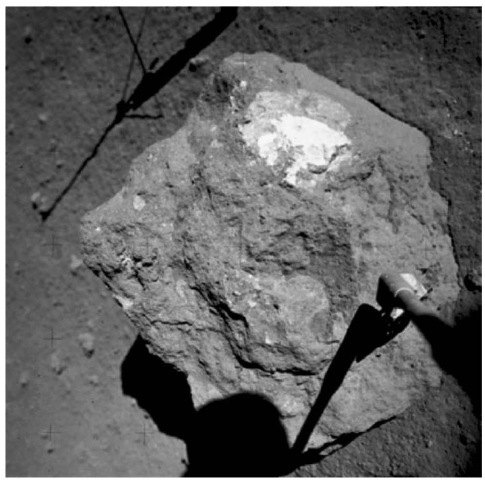
Figure 8. The clast of nearly pure olivine rock (dunite) sampled by the Apollo 17 crew at Station 2 at the base of the South Massif and dated as having crystallized 4.5 b.y. ago. The clast is enclosed in a blue-gray impact breccia and is a member of the Mg-suite of lunar rocks.
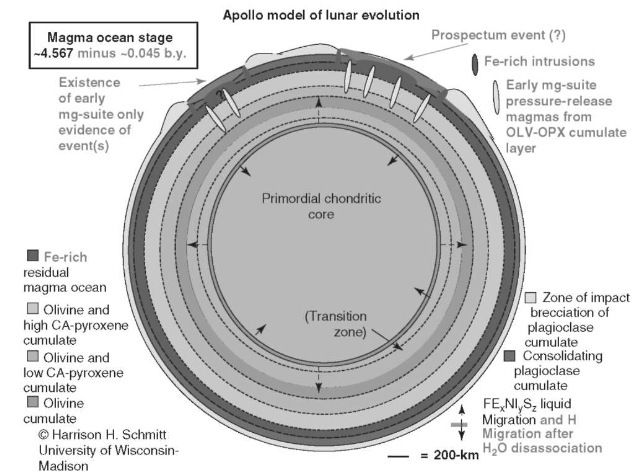
Plate 5. Apollo model of lunar evolution—Magma Ocean Stage ~ 4.567 minus b 0.045b.y.
When the crystallization of the Magma Ocean was about 90-95% complete (281,282) and as iron and titanium concentrations in the residual Magma Ocean increased, ilmenite [FeTiO3] became the last major mineral to crystallize and settle from the residual magma (Plate 6). Ilmenite-rich cumulates (3-12% ilme-nite), accompanied by continuing formation of increasingly iron-rich olivine and pyroxene and increasingly sodium-rich calcium plagioclase, became an important constituent of the upper portion of the lunar mantle. For example, high-titanium mare basalt magmas produced by later partial melting of the mantle appear to have originated at depths between 100 and 200-km below the surface (283), plausibly a region of ilmenite-rich cumulates. The trace element ratios of such basalts also support their origin from partial melting of late ilme-nite-rich cumulates. Europium depletion in the titanium-rich basalts, as in all mare basalts (284-286), indicates extensive previous plagioclase separation from the parent Magma Ocean. Further, ilmenite’s precipitation from the Magma Ocean would deplete niobium in the residual liquid (287). High Nb/U and Nb/Th ratios in high-titanium Apollo 17 basalts (288) reflect the consequent enrichment of this element in the ilmenite-rich cumulates and are consistent with an origin for these basalts through partial melting of such cumulates. Ilmenite crystallization also depleted hafnium in the remaining liquid (289). The high-titanium basalts sampled by Apollo 17 (see discussion of the Basaltic Maria Stage, below) have high radiogenic 182W and high Hf/W ratios (290). This is consistent with ilmenite cumulate crystallization while significant 182Hf (half-life 9m.y.) existed, probably less than B50 m.y. after the origin ofthe solar system (291). There have been recent suggestions that the late ilmenite-rich cumulates, once formed, sank to greater depths in the other cumulates of the upper mantle (292-294) because of ilmenite’s high density relative to the underlying olivine-pyroxene cumulates (4.7 gm/cm3 vs. ~3.5gm/cm3, respectively). The average density of the ilmenite cumulate, however, would be only slightly higher than the olivine-pyroxene combination. The apparent relatively shallow depth of origin of titanium-rich basalts sampled by Apollos 11 and 17 would also contradict this hypothesis, at least for the eastern regions of the lunar nearside.
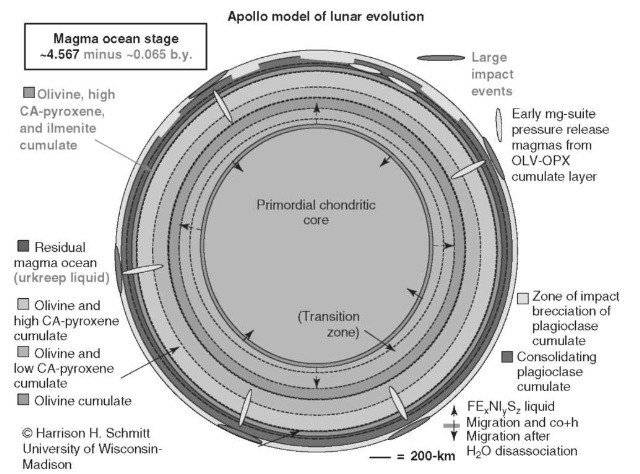
Plate 6. Apollo model of lunar evolution—Magma Ocean Stage ~4.567 minus b 0.065 b.y.
When ilmenite appeared, the continued crystallization of the four major minerals produced by the Magma Ocean (olivine, pyroxene, plagioclase, and ilmenite) largely completed the formation of the upper lunar mantle (that is, the mantle above about 500-km and below the base of the crust). After about 99% of the Magma Ocean had solidified (295), however, a geochemically significant amount of residual silicate liquid would have remained below the crust. Fractional crystallization of the major minerals would have enriched this liquid in silicon (Si), potassium (K), and incompatible elements (296), that is, most rare-earth elements (REE), phosphorus (P), uranium (U), and thorium (Th). Dissolved volatiles, including hydrogen (H) and carbon monoxide (CO), also would be concentrated in this remaining magma. This residuum has been named “urKREEP” to distinguish it from an apparently related component in Apollo samples that was originally called just “KREEP.” Tungsten (W) also would be enriched in urKREEP and represents a special case. After the early separation of much of the siderophilic trace elements by the rapid precipitation of FexNiySz liquid, any residual such elements, including tungsten and subsequently formed radiogenic 182W, would be gradually concentrated in the residual Magma Ocean as incompatible elements. As a residual silica-rich liquid, urKREEP would have existed as a liquid at temperatures lower than those of the original Magma Ocean. Such a liquid would have potentially stayed molten as a result of the concentration of radioactive, heat-producing isotopes and the insulating effects of the Cratered Highlands forming on the upper crust (see discussion below).
Some outward transfer of heat by convection in the cooling Magma Ocean seems likely during much of the Magma Ocean Stage (297-299). On the other hand, as solidification proceeded, potential convection cells would have been increasingly restricted. Convective tendencies also would have been reduced by cooling of the young Magma Ocean through continued impact splashing in its upper portions, a major factor not yet included in models of thermal evolution. The importance of splash cooling may be suggested by indications, discussed before, that the Magma Ocean largely solidified in 50 m.y. or less. Subsequently and throughout lunar history, there is no direct evidence that mantle convection was a significant thermal transfer process. That convection was not important is indicated by recent thermal modeling investigations (300). Further, little or no evidence of mantle convection exists at the surface unless the ~2000-km long, north-south volcanic ridge system in the western portion of the Procellarum Basin implies that such activity existed beneath this region (301). (Alternatively, this Procellarum ridge system may reflect a cryptic crustal structure associated with the transient crater of the Procellarum basin-forming event discussed below.) After the Magma Ocean crystallized to become the upper mantle, conduction and upward migration of partial melts were probably sufficient to prevent any major density instabilities that would lead to solid or nearly solid-state convection in the one-sixth gravity environment of the Moon. Cooling sufficient for the solidification of all but the radioisotope-rich, late residual liquid of the Magma Ocean took place in about 150 7 70 m.y. after accretion, based on Sr/Rb model ages for closure of the isotopic systems in KREEP (302). The hafnium-tungsten isotopic system (303) indicates that of the majority of the Magma Ocean solidified within 50m.y., a time close to the lower limit of the Sr/Rb system closure uncertainty.
Cratered Highlands/Very Large Basins (Stage 3—Pre-Nectarian). The Cratered Highlands/Very Large Basin Stage of lunar evolution (Plate 7) represents the early Pre-Nectarian of the US Geological Survey time-stratigraphic system (304) and records the sustained violence of the first few hundred million years in the history of the Moon and the terrestrial planets. The stage commenced as the developing lunar crust gained consistent stability and coherence sufficient to retain the imprint of craters excavated largely by the continuing in-fall of residual, preaccretion debris and/or meteors, as well as comets ejected from the outer solar system. Crystallization ages of several Apollo 17 samples of the Mg-suite of rocks and Sr-Rb model ages, as discussed before, suggest that this period began about 4.5 b.y. ago and overlapped the previous Magma Ocean Stage as the last residua of the Magma Ocean continued to crystallize and differentiate. Similarly, recent Sm-Nd isochron ages for two ferroan anorthosite clasts from an Apollo 16 highland breccia are ~4.54 and 4.40 b.y. (305). A possible lower limit for the duration of the stage is 4.2 b.y. (306) at which time most K-Ar radiometric clocks in Apollo 16 breccias of apparent Pre-Nectarian age were reset. The sustained high rate of impact probably resulted from preaccretion debris remaining in crossing orbits (307,308) and the ejection of material from orbital bands in resonance with the gas-giant planets (309). There also remains a possibility for the accretion of any original moons or rings of Earth after capture of the present Moon (310) or its aggregation from a circumterrestrial disk (311). As the Cratered Highlands formed, the crust saturated with craters at a saturation size (measured by curves of crater size vs. frequency that approach a slope of — 1) of 60-70-km in diameter (312) (Fig. 9). This means that a relatively uniform me-garegolith, including any heterogeneities introduced into the crust by Mg-suite magmatic intrusions, developed to a depth of at least 25 km, the approximate depth to which Apollo passive seismic interpretations indicate that intense fracturing of the upper crust exists (313). Although average depths of about 20-km for the megaregolith have been proposed (314), brecciation to the greater depths suggested by seismic data is plausible due to the near superposition of many large craters and impact-generated fractures that extend below the transient floor of each crater. The superposition of ejecta blankets from large basins, on the other hand, will have produced much thicker regional zones of megaregolith, even though lithostatic pressure may have closed most fractures below 25 km. During this stage, regional textural homogenization of the upper crust down to the base of the megaregolith was indicated by the pre-Apollo lunar mapping program (315) and by the sample suites from Apollo 16 (316). Apollo 17′s impact breccias related to the Serenitatus event (boulders at Stations 2, 6, and 7) also record crustal recycling by many earlier basin-forming and cratering events. These breccias further illustrate the processes and incomplete degree of mixing (317,318). The regional nature of the compositional homogenization process during this period has now become broadly defined by remote sensing of the lunar highlands from the more recent Galileo (319-321), Clementine (322), and Lunar Prospector (323) spacecraft. This process, however, appears to have added less than 0.3% of an extralunar component to the Cratered Highlands (324) if iridium is considered a surrogate for that component.
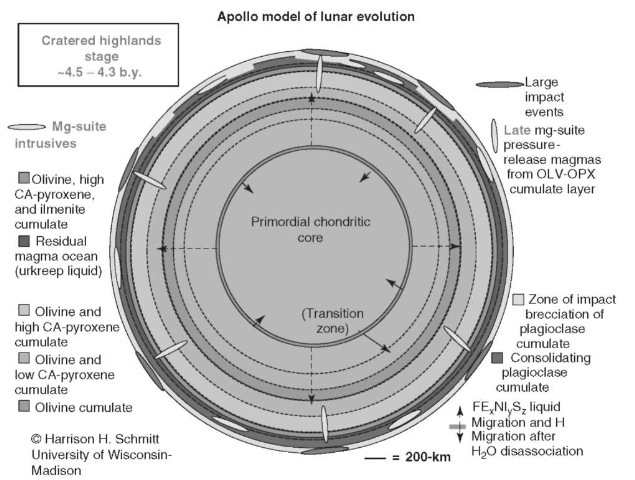
Plate 7. Apollo model of lunar evolution—Cratered Highlands Stage ~4.5-4.3b.y.
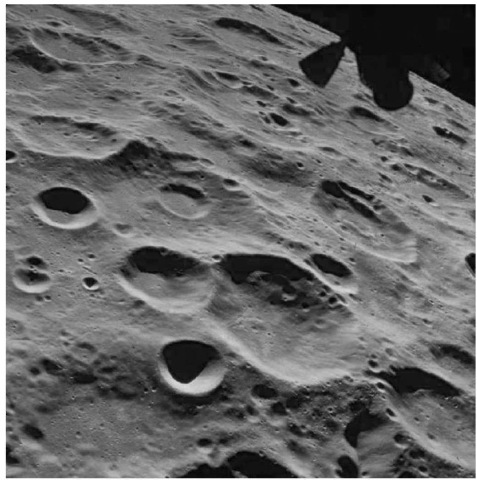
Figure 9. Typical Cratered Highlands on the farside of the Moon.
The creation of the majority of large basins, discussed in the next section, followed the Cratered Highland Stage as a distinct period in lunar evolution. Two and possibly four extremely large impacts events (325-327), however, upon which later large basins are superimposed, may have occurred during this stage. Two of these formed the nearside Procellarum Basin and the farside South Pole-Aitken Basin (Fig. 10). These two basins are about 3200-km (transient crater ~2100-km) and 2500-km (transient crater ~2000-km [?]) in diameter, respectively. An older, third structure or cryptic basin ~ 3000-km in diameter, centered roughly on Mare Tranquillitatis, is indicated by a partial ring of anomalously high iron plus titanium seen in the Lunar Prospector thermal neutron data between latitude + 30° and – 45° and longitude + 60° and + 120° (328) (Plate 5). The center of the transient crater of this very large cryptic basin, tentatively referred to as the Prospector Basin, coincides roughly with the global selenopo-tential low at the lunar surface. Prospector may have been responsible for the present ~2-km offset in the center of the figure from the center of mass (329) that produces this low. The lack of physiographic and strong geochemical definition of Prospector suggests that it would have been formed before full consolidation of the anorthositic crust ~ 4.5 b.y. ago and before a signature of the concentration of KREEP components in the residual Magma Ocean could be left in the crust. Without other distinguishing geochemical signatures, Prospector’s ring of anomalous iron plus titanium in the crust, now nearly homogenized with the Cratered Highlands of the region, may represent a trace of partially differentiated Magma Ocean brought to the surface around the transient crater.
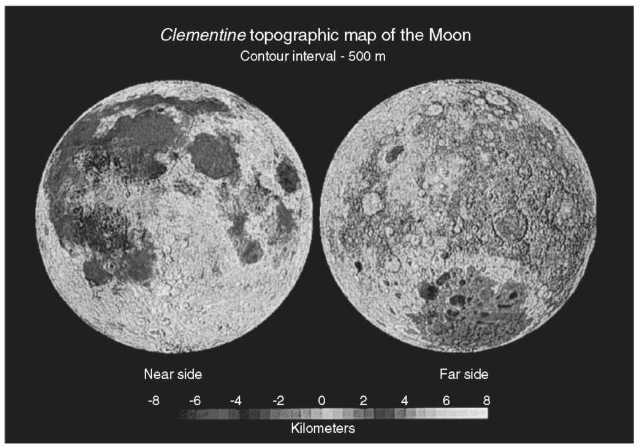
Figure 10. Topographic map of the Moon from Clementine data showing the Procellarum Basin in the upper left of the nearside image, the South Pole-Aitken Basin in the lower portion of the farside image, and the Cratered Highlands of the farside and southern nearside.
The Procellarum event (Plate 8) may have taken place in the midportion of the Cratered Highlands Stage, possibly about 4.3 b.y. ago, if the impact degradation of its surrounding rings is any indication. Crystallization ages near 4.3 b.y. for some of the Apollo 14 KREEP-related samples may be related to the Procellarum event. In response to such an event, KREEP-rich basalt intrusions and extrusions might have been emplaced throughout the Procellarum region (330). However, 700 m.y. later, extensive eruptions of mare basalt partially filled the Procellarum Basin and other basins contained within it (see below) and covered most materials created or emplaced as a consequence of the Procellarum event. Beneath the transient Procellarum crater, pressure-release melting of oli-vine and low calcium-pyroxene cumulates (harzburgite), if those cumulates were near their partial melting temperature, would have produced intrusive magmas that may have crystallized the relatively young members of the Mg-suite of samples (331). The Procellarum impact also would have removed the early formed Cratered Highlands from the region. Present crustal thickness modeling for the region is consistent with thinning of the crust from about 70-km to about 40-km thick (332,333). By removing a large area of insulating megaregolith and requiring that a new zone of insulating crust develop subsequently, the event also may have delayed future remelting of the underlying upper mantle to produce mare basalt magmas. Crystallization ages of mare basalts (334,335) sampled by Apollo 12 and 15 within the Procellarum Basin are younger (3.1-3.4b.y) than mare basalts to the east (3.6-3.9 b.y.) sampled by Apollo 11 and 17. On the other hand, the ages of mare basalts fragments in the more limited Luna 16 and 24 samples from Mare Fecunditatis and Mare Crisium, respectively, east of the Apollo 11 and 17 sites, are in the 3.3-3.6 b.y. range. An Ar-Ar age from Mare Fecunditatis basalt is 3.417 0.04 b.y. (336), and two Ar-Ar ages from Crisium basalt fragments are 3.30 7 0.04 b.y. (337) and 3.617 0.12 b.y. (338). These relatively young ages maybe the result of basaltic maria appearing first at the selenopotential low and then progressively away from that low (339) or of an as yet unrecognized, very large basin-forming event in that region removing older Cratered Highlands, as suggested before for Procellarum. Some suggestion for such a very large event centered on the equator southeast of Crisium is apparent in the gravity models based on Lunar Prospector data (340,341) and in the albedo maps from Clementine (342) (Clementine may be an appropriate name for this possible basin). Mare Australus consists of the basaltic lava fill of many craters and low areas in a ~ 1200-km diameter basin that also may indicate a very large impact.
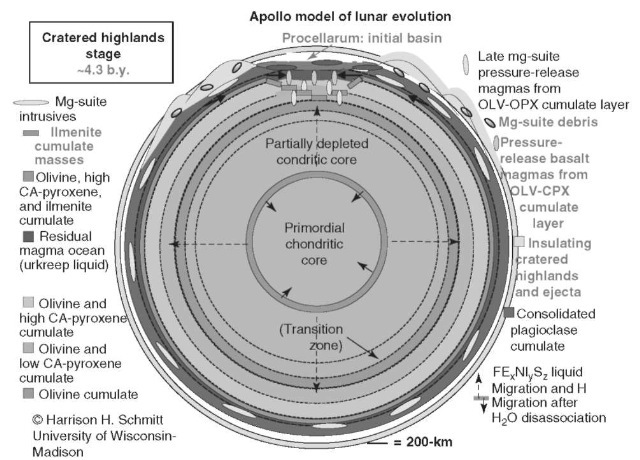
Plate 8. Apollo model of lunar evolution—Cratered Highlands Stage ~4.3b.y.
The largely farside South Pole-Aitken Basin is the largest and oldest unambiguous impact basin on the Moon (343-348). It can be argued that the South Pole-Aitken event (Plate 9) took place near the end of the Cratered Highland Stage. For example, this event removed most of the insulating megaregolith of the Cratered Highlands and also thinned the total crust thickness to about 40 km (349); however, little new insulating megaregolith formed afterward. Gravity modeling also indicates that the lunar crust has been thickened by ejecta on the highlands surrounding South Pole-Aitken. If the Procellarum Basin is also the result of an impact, the combination of ejecta of Cratered Highlands material from South Pole-Aitken and Procellarum thickened the crust between them to about 120 km. The Galileo, Clementine, and Lunar Prospector remote sensing data have produced additional insights about South Pole-Aitken. Although actual magnesium to iron ratios have not been determined, these data suggest that most of the dark albedo surfaces in that basin, where iron, titanium, and potassium are lower than in mare basalts, may be related to impact melting of noritic or gabbroic Mg-suite rocks within the lower ferroan anorthosite crust. As in the Procellarum, Mg-suite related lavas may have been generated by pressure-release melting of the mantle’s olivine-orthopyroxene cumulates beneath South Pole-Aitken. The presence of a weak KREEP signature in the South Pole-Aitken Basin may indicate that deep Mg-suite masses included some in-trusives derived from Magma Ocean residual liquids of intermediate maturity. Imbrium ejecta in this region, however, cannot be eliminated as a source of KREEP-bearing material (350,351). In spite of a basin depth of 12 km below the mean lunar radius, mare basalt appears to be rare in the basin (352). South Pole-Aitken removed essentially all of the insulating surface layer without time for replenishing it, as indicated by the better definition of related physiographic features relative to Procellarum. The South Pole-Aitken event thus appears to have prevented the later large-scale remelting of underlying upper mantle cumulates and the subsequent regional eruption of mare basalt, even though significant heat-producing, KREEP-related materials may be present in the underlying crust. Some local mare basalt signatures, however, have been identified in the northern portions of the basin (353), suggesting late partial melting of the underlying mantle, as occurred elsewhere on the farside of the Moon.
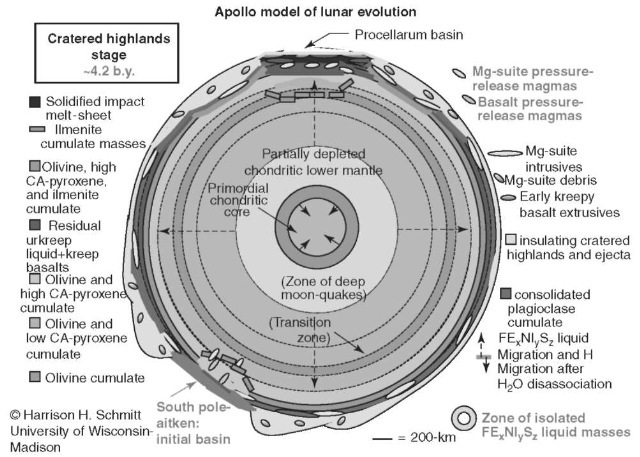
Plate 9. Apollo model of lunar evolution—Cratered Highlands Stage ~ 4.2 b.y.
Thermal neutron spectra obtained by Lunar Prospector disclose a zone of high iron plus titanium, relative to other nearby crustal elemental signatures, just outside the rim of both the Procellarum and South Pole-Aitken Basins (354). These annuli suggest that material at and immediately outside of the now exposed rims of the Procellarum and South Pole-Aitken Basins came from deep crustal or upper mantle rocks. Until the magnesium content of these annuli is determined, their full significance will be uncertain; however, both events may have excavated levels of the lower crust that included abundant mafic material, possibly Mg-suite intrusions. This conclusion is consistent with new assessments of Apollo passive seismic data (355) which indicate a gradual increase in crustal density from 2.9-gm/cm3 in the upper crust to 3.4-gm/cm3 at the crust-mantle boundary. Lunar Prospector gamma-ray spectrometer data (356), on the other hand, indicate that neither of these enormous events excavated significant material related to urKREEP. This strongly suggests that urKREEP magmas had yet to move into the Moon’s lower crust at the time of each event, a magmatic episode discussed further later in connection with the Old Large Basin Substage when urKREEP apparently did move upward on a global scale.
The extensive movement of residual Magma Ocean liquids across and possibly along the crust-mantle boundary region may well have occurred beneath both Procellarum and South Pole-Aitken in response to the regional reduction in lithostatic pressure that would coincide with their formation (357-359). The coincidental formation of another large basin, the 1160-km diameter Imbrium basin near the center of Procellarum, further resulted in the redistribution of KREEP-related materials in and roughly radial to Imbrium (360). This scenario for urKREEP migration after a postulated Procellarum event provides an alternative to recent proposals of chemically asymmetrical differentiation of the Moon (361-365) to explain the present surface concentration of KREEP-related material around Imbrium. In this regard, an extreme concentration of KREEP-related material in the Procellarum region has been postulated in the form of the ”Great Lunar Hot Spot” (366) now generally referred to as the ”Procellarum KREEP Terrane (367). Asymmetry by the end of Magma Ocean solidification is also inherent in suggestions of the overturn of ilmenite cumulates (368) and overall mantle instabilities (369). On the other hand, if the Magma Ocean solidified in a roughly spherically symmetrical manner, such a KREEP-related concentration would not be expected as a consequence of differentiation. Like any fluid in orbital space, a Magma Ocean would tend to form a spherical shell subject to rotational, tidal, and convectional stresses. A generally spherically symmetrical solidification of this shell on the Moon is suggested strongly by (1) the pervasive evidence of both an originally global anorthositic crust, as discussed previously, and (2) globally distributed eruptions of mare basalts derived by partial melting from mantle cumulates (see Basaltic Maria discussion below). What asymmetries, if any, may have been introduced by rotational, tidal, and convectional stresses are not yet clear.
As implied before, one of the most important effects of the formation of the Cratered Highlands was a reduction in the thermal conductivity of the crust. As indicated by Apollo passive seismic data (370,371), low thermal conductivity corresponds to the high scattering and low attenuation of seismic waves that exist in this upper zone or megaregolith of the lunar crust. Thus, individual rock particles in the outer 25 km of the crust would be dominantly in point contact with each other and can be expected to be highly insulating thermally. Thermal transfer would be largely by radiation between particles rather than by conduction. The increasingly insulating character of the pulverized upper crust over that which would have prevailed during the crystallization of most of the Magma Ocean would arrest the cooling of the residual Magma Ocean during the Crate-red Highlands Stage. It allowed the gradual accumulation of radiogenic heat necessary eventually to remelt partially the source regions in the upper mantle that subsequently produced the mare basalts and various pyroclastic volcanic eruptions. The resulting downward wave of heating would proceed into the upper mantle from the still molten and significantly radioisotopic urKREEP residual liquid at the base of the crust. This heating would be augmented by radioactivity retained interstitially within the deeper Magma Ocean cumulates. Proposals related to a Procellarum ”hot spot” discussed before have led to a suggestion that a radiogenic heating mechanism by itself could explain the concentration of basaltic maria on the lunar nearside (372). The thermal models developed in support of this proposal indicate that such a concentration of radiogenic heating would have kept the urKREEP zone beneath the crust molten for a few billion years. Maintaining urKREEP in a molten state only beneath Procellarum, however, does not explain the presence of isolated basaltic maria in deep farside craters (373,374). More critically, it cannot explain the persistence of gravitational anomalies due to mass concentrations (mascons) in the Procellarum Basin after 3.9 b.y. ago (see following Large Basin Stage discussion). The evidence is strong that the residual Magma Ocean had fully solidified in the crust by the time the young, mascon basins had formed. Although some significant migration of urKREEP liquids toward the Procellarum region may have occurred after the Procellarum basin-forming event, mare basalt magmas probably were prevented by the thicker farside crust from reaching the surface on the farside to the extent seen on the nearside. In the specific case of South Pole-Aitken, the loss of the insulating Cratered Highlands would have limited the remelting of the underlying upper mantle.
Large Basins (Stage 4—Pre-Nectarian-Lower Imbrium). Apollo 17 and Apollo 15 landed in the proximity of major structural features related to the formation of Serenitatis and Imbrium, respectively, two of the approximately 50 large circular basins on the Moon (Fig. 11). The extreme, but less than ~ 100-km diameter scale cratering intensity that characterized the Cratered Highland Stage of lunar evolution had waned significantly before these and most other large basins were formed by extremely large and energetic impacts (375). This conclusion is consistent with the relatively good preservation of the concentric ring structures and some features of the surrounding ejecta blankets of most basins defined as “large,” whose diameters are greater than 300-km (376). In aggregate, crustal thickness determinations (377) indicate that these basins have redistributed large volumes of the upper 10-30-km of the fragmental debris (megaregolith) of the Cratered Highlands, particularly on the nearside of the Moon. Preservation of many of the physiographic features of the majority of large basins contrasts sharply with the vagueness or absence of similar features related to the very large basins (Procellarum, South Pole-Aitken, and possibly Prospector and Clementine) that formed during the Cratered Highlands Stage. These earlier very large basins may indicate that many more such basins formed, possibly about 14 (378), only to be destroyed by the combined effects of later basin forming and the overall, very high cratering rate during the Cratered Highlands Stage. As noted before, the Cratered Highlands are saturated with craters 60-70-km in diameter (379), a size-frequency parameter that requires a much higher rate of cratering than recorded in subsequent lunar history. Although little direct evidence of more than a few, very large “cryptic” or hidden basins yet exists and analyses of the uniformity of anorthosite distribution suggest that few actually formed (380), the previous existence of at least some cannot be ruled out, such as the possibility of Clementine, southeast of Crisium, discussed previously. One other such cryptic basin may encompass the roughly 2000-km diameter farside region that includes the smaller basins Mendeleev, Moscoviense, and Freundlich-Sharonov. This region appears to have a crustal thickness 20-30-km less than surrounding highlands (381) but no other indications of a very large basin event.

Figure 11. Near full Moon view showing examples of old and young, large basins both containing basaltic maria. The irregular basin at the lower left of center is Tranquillitatis, whose southern portion contains the Apollo 11 landing site. The circular basin at the lower left is Serenitatis. The Apollo 17 landing site is located in the lower right portion of the surrounding ring of mountains. The farside mare basin, Tsiolkovskiy, is visible just right of the top.
Large crater-forming events that formed a specific period in solar system history may have continued for several hundred million years after the less energetic background impacts of the Cratered Highlands Stage had largely ceased. A strong presumption can be made that a source of objects discrete from that which caused the earlier intense cratering was responsible for most large basins in the period between 4.2 and 3.8 billion years (382,383) or was part of a “cataclysm” at about 3.85 billion years (384,385). A discrete source is required even if a short-lived cataclysm is assumed. How long the large basin impact period lasted will be discussed further later; however, this discrete source supplied far fewer, but far more energetic objects (more massive and/or higher velocities) than the source responsible for the intense, postaccretion cratering that created the Cratered Highlands. Four possibilities for sources of the impactors of the Large Basin Stage appear plausible at this time: (1) the proto-Kuiper Belt of cometary objects whose injection into the inner solar system was the result of orbital resonance with Neptune (386); (2) the injection of Oort cloud cometary objects at rates greater than during the last 3.9 b.y. as a consequence of perturbations by a passing stellar body (387); (3) large protomoons of Earth, swept up by the Moon during and after capture (388)); and (4) Jupiter’s initial interaction with the Main Belt Asteroids, or its induced breakup of the Belt’s planetesimal precursor, and injection of fragments into inner solar-system-crossing orbits by orbital resonance (389). Of these possibilities, Jupiter’s initial interaction with Main Belt Asteroids and/or the breakup of the original Main Belt planetesimals or ejection of Kuiper Belt objects due to interaction with Neptune appear to be the best present choices as discrete impactor sources. Modeling studies suggest that interactions between Neptune and Kuiper Belt objects probably would be completed over time frames of about 10 million years, although time frames of the order of hundreds of millions of years may be involved in the formation of the Kuiper Belt itself (390). An Oort Cloud source is currently unconstrained by modeling studies, but it seems likely that it continued to supply similar objects off and on indefinitely, given its postulated large total mass. Assimilation of protomoons of Earth, if any existed, would have involved objects of low kinetic energy relative to a coorbiting Moon, would occur over a shorttime interval, and would not explain large basin formation on other planets. At this stage of knowledge, however, it does not appear that any of these possibilities can be totally eliminated. Conversely, future studies of potential interactions of the gas giants with the Kuiper Belt and of passing stellar neighbors with the (Oort Cloud might include the hypothetical constraint of large basin formation on the inner planets between about 4.3 and 3.8 billion years ago or of a short cataclysm.
Old Large Basins/Crustal Strengthening (Stage 4a—Pre-Nectarian)
Globally, comparison of the old large basins with younger large basins (391) indicates that major strengthening of the lunar crust occurred during the early portion of the Large Basin Stage (392). The younger basins of the Nectarian and Lower Imbrium Systems, including Serenitatis, are circular and sharply defined structurally and physiographically. Central mass concentrations (mascons) underlie the young basins and are surrounded by mass deficiencies under mountainous rims several thousand meters high (393-395). Analysis and modeling indicate that most of the mascon signal comes from thick plates of basalt that partially fill the young basins in contrast to relatively thin basalt fill in older basins. A small part of the mascon signal may come from upward bulges in the crust-mantle boundary. A very large amount of mare basalt as hidden intrusions in the megaregolith beneath the basins may also contribute. On the other hand, the old basins are only irregularly circular, have relatively low mountainous rims, underlie ejecta from young basins, and today are largely compensated for gravitationally, that is, they have no mass concentrations or deficiencies associated with them. Thus, old large basins have adjusted isostatically, but young large basins have not (396) (Plate 10), leaving the latter with deep holes for mare fill and uncompensated for mass deficiencies beneath their ejecta rims. This suggests that the fracturing of the lunar crust by the older basin-forming events permitted urKREEP liquids to migrate into the crust. When these liquids moved upward and solidified, the potential was lost for rapid, postimpact isostatic adjustment by urKREEP magma movement at the crust-mantle boundary. A strengthening boxwork of solidified KREEP-rich intrusions also would be created in the lower crust. Although old basins also have some mare fill, higher basin floors would result in thinner mare basalt plates than in younger, unadjusted basins. If this hypothesis is correct, the remnants of the Magma Ocean remained in liquid form until about 3.92 7 0.03 b.y. ago. This is the apparent age of Nectaris (397,398), apparently the oldest basin that has an uncompensated for mascon (399). The Apollo sample suite lacks clear-cut examples offerroan anorthosite in association with material that might be interpreted as urKREEP intrusive. Except for Apollo 15 KREEP basalts, rocks that have a strong KREEP chemical component have been found only as impact melt breccias. These two observations (400,401) suggest that urKREEP intrusives are confined to the lower crust and have been exposed only in a single deep excavation, namely, Imbrium, where impact melting predominated. Probably because of the thinning of the upper crust by coincidence of the Imbrium transient crater with that of the Procellarum event, 3.83-3.86 b.y. old mare basalts (402) mixed with older KREEP-rich material may have reached the surface in that region roughly coincident with the Imbrium event at 3.82 b.y. (403).
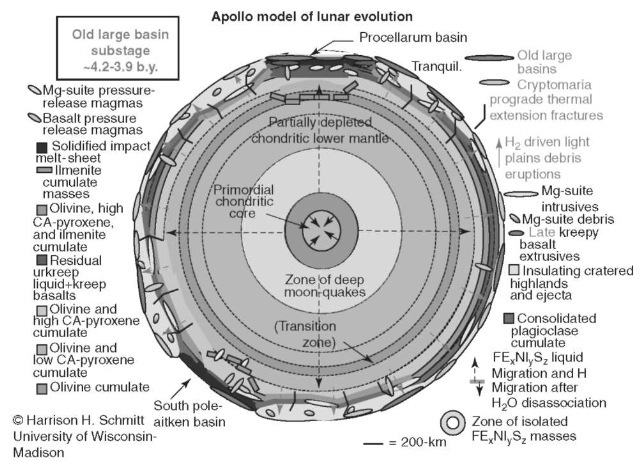
Plate 10. Apollo model of lunar evolution—Old Large Basin Substage ~4.2-3.9b.y.
Recent studies (404) have increasingly extended the areas of the Moon in which craters that penetrated young large basin eject deposits have exposed older dark materials that have basaltic characteristics, the so-called “cryptomaria” (405-408). The cryptomaria are related in age to the old, large basins because they also lie under ejecta from the young, large basins which is why they are “cryptic.” The volume of these apparently basaltic lavas of pre-Young Large Basin age is uncertain, but may be of the order of 106-km3 (409) compared with basaltic maria volume estimates of the order of 107-km3 (410). Cryptomaria may be represented in the Apollo samples by basalts of ages clearly greater than 3.92 b.y. (411,412) or by KREEP-related basalts whose model ages are 4.2-4.4 b.y. (413). Most pre-3.92b.y. basalts have high aluminum content, and others have KREEP affiliations and a variety of unusual chemical combinations (414). This chemistry may be explained by derivation from either urKREEP residual liquids or pressure-release partial melts of shallow Magma Ocean cumulates positioned between 100-km and 200-km depth and just below the radioisotope-rich, residual liquids of the Magma Ocean. Movement, intrusion, and eruption of magmas derived from residual liquids at the crust-mantle boundary and deeper pressure-release melting of a mantle near its partial melting point would occur in response to structural disruptions and the removal of tens of kilometers of overlying Cratered Highlands megaregolith. Such disruptions would accompany extraordinary events like those that created Procellarum, South Pole-Aitken, and other old, large basins. Future comparisons of the details of Lunar Prospector’s gamma-ray spectrometer data and of relatively large areas of identified cryptomaria exposure may help further discriminate and define their source or sources, particularly if a KREEP signature becomes apparent. Such a signature would be expected for magmas from or passing through zones near the base of the crust. If it turns out that the compositions of cryptomaria are not significantly related to KREEP, it would suggest very rapid ascent of their magmas or their eruption in the narrow time window before the formation of young large basins and after the solidification of urKREEP liquids in the lower crust. The identification of cryp-tomaria on a global scale has other implications. The eruptions of early partial melts or urKREEP residual liquids from beneath the lunar highlands may have included significant residual volatiles and been at least partially pyroclastic. As a consequence, they may have contributed to the formation of light plains deposits or Cayley Formation units (415,416). Such smooth, light colored units in the lunar highlands actually may have several origins. In nearside regions affected most by young large basin events, they may be largely the result of the uniform settling of material in fluidized debris flows that extended beyond zones of continuous ejecta. On the other hand, those deposits observed by the author in old craters in the farside highlands may be the result of internal processes. An origin by pyroclastic eruptions dominated by entrained, fine-grained crustal debris is suggested by the smoothness of these plains, their similarity in albedo to other highland surfaces, irregular rimless depressions in their surfaces, and the absence of nearby young, large basins as sources of fluidized debris.
The formation of each of at least 29 old, large basins, including Procellarum and South Pole-Aitken, had five, essentially global effects. First, upper crustal material was redistributed regionally as ejecta blankets, debris flows, and impact melt flows and intrusions. Second, excavation and broad distribution of Mg-suite rocks and impact melts from solidified intrusions in the lower crust occurred. Third, regional thinning and thickening of the crust took place. Fourth, the lower crust beneath each basin was fractured extensively. And fifth, local areas of temporarily low lithostatic pressure were created under each basin, and mantle material at or near its partial melting point was commensurately mobilized. After each large basin formed, the relatively low-density, immediately underlying, urKREEP liquids would tend to move upward into the fractured lower crust and brecciated upper crust. In the process, those liquids, probably with small amounts of superheat due to pressure release, would assimilate and mix with both ferroan anorthosite and differentiated Mg-suite masses, creating the diversity of parent magmas indicated by KREEP-rich samples from the Apollo landing sites (417). As they cooled, significantly contaminated KREEP-related magmas crystallized into networks of compositionally varied intrusions. In the Procella-rum and possibly other deep old basins, KREEP-related magmas and pressure-release magmas may have reached the floor of the basins only to be largely buried by younger, large basin ejecta and mare basalt eruptions. Pre-Nectaris crystallization ages of 4.2 b.y. (418) for some olivine-rich and aluminous KREEP-related basalts are consistent with this scenario.
Apollo 17 sampled some of these effects of the Old Large Basin Stage during the examination of boulders at the base of the Massifs of the Valley of Taurus-Littrow. The Serenitatis basin-forming impact partially exposed a complex sequence of roughly layered ejecta blankets (Table 2, Plate 11) in the massif walls. Layers probably include significant ejecta from at least three, old Pre-Nectarian basin-forming events, Procellarum, Fecunditatis, and Tranquillitatis, as well as the younger basins, Serenitatis and Imbrium. It is possible that samples from these ejecta units are included in those collected at Stations 2, 3, 6, and 7 at the bases of the South and North Massifs. The most likely possibilities are samples from Boulder 1 at Station 2 (419). Rb-Sr isochron ages between 4.2 and 4.0 b.y. for some of the clasts in this boulder suggest that the probably older Procellarum ejecta is not represented unless that event was the source of the fine-grained plagioclase clasts whose Rb-Sr isochron ages are about 4.4 b.y (420).
Young Large Basins (Stage 4b—Nectarian-Lower Imbrium). Between 3.92 7 0.03 b.y. (Nectaris event) and 3.80 7 0.05 b.y. (Orientale event), 14 large basins formed (421,422) in a lunar crust that could support significant mass concentrations and deficiencies indefinitely (Plate 12). Alternatively, it has been suggested (423-425) that a lunar cataclysm between 3.9 and 3.8 b.y. created these basins and also the 29 or more older, nonmascon basins and the Cratered Highlands as well. This latter hypothesis rests on the predominance of ages in that range that have been measured for impact glasses in Apollo, Luna, and lunar meteorite samples from the highlands and from basin-related materials. In this context, note that all Apollo and Luna sampling took place within the regions most affected by young, large, basin-forming events and a predominance of ages related to those events would be expected. This influence also may have extended globally to affect the lunar meteorite samples. Advocates for a cataclysm argue that the influence of impact melting and thus the resetting of ra-diometric ages is limited to the near vicinity of the basins. This may not be the case as lunar mapping (426) and experimental results (427) suggest that very large amounts of impact melt form within the transient crater of a basin, and also such melt is widely distributed on and in ejecta. Ejected melt particles of the highest energies will have a global reach in large basins. Even so, impact melts from the highlands sampled by Apollo 16 show formation ages up to 4.2 b.y. (428), and, as noted before, Rb-Sr ages for clasts in breccias sampled by Apollo 17 also show ages up to 4.2 b.y. The question whether 50 or more large basins formed in about 100 million years or less or in about 400 million years will ultimately be determined by more extensive sampling of the lunar highlands.
Table 2. Local Sequence from Younger to Older of Pre-Mare Basalt Stage Events in the Vicinity of the Valley of Taurus-Littrow (For Regolith Depth: Shallow — 0.01-1 Meters, Moderate — 1-10 Meters, and Deep — 10-100 Meters)
Table 2. (Continued)
The vast majority of the nonmare materials accessible to Apollo 17 in the Valley of Taurus-Littrow represents large basin ejecta derived from the Cratered Highlands or the upper lunar crust. Using the relative ages of the large basins (429), approximate ejecta thickness expected from such basins (430), and radi-ometric ages determined for specific impact-related events near Taurus-Littrow, the general characteristics of the local sequence of events are given in Table 2 and Plate. 11. Investigations of the large boulders of impact melt breccia at Station 6 and 7 at the base of the North Massif in the Taurus-Littrow area documented the complexity of processes associated with large basin-forming events. The prevalence of melt breccia in the boulders suggests that they tie genetically to the 740km diameter Serenitatis basin whose rim is 15-20-km to the west. The track to the largest of the boulders (Fig. 12) indicated that it had rolled down from a break in the slope ~500-m above the valley floor, ~ 1000-m below the top of the North Massif (431), and probably near the base of Serenitatis ejecta. The higher, ~25° slopes include outcrops or near-outcrops; some appear roughly horizontal in aspect. For the first time on the Moon, this boulder permitted observations and sampling across a major lithologic and structural contact related to a large impact (Fig. 13). A finely crystalline melt breccia—tan-gray and highly vesicular (Fig. 14)—intrudes, is in, or was laid down in contact with crystalline nonmelt breccia—blue-gray, nonvesicular and clast-rich (Fig. 15). An approximately 1-m wide zone in the nonmelt breccia contains small vesicles at and near the contact with the melt breccia. At Station 7, a vein of crystalline melt breccia cuts across the contact zone and through a clast, suggesting that the melt breccia may be largely intrusive. Laboratory investigations of the samples from these boulders indicate an age of crystallization for the melt breccia of 3.87 7 0.08 b.y. (432), giving the probable age of the Serenitatis basin-forming event. The petrographic and chemical characteristics of the melt and nonmelt breccias indicate that each is polymict (multiple types of fragments) and have crystalline matrices. The matrices show a continuum in texture between very finely crystalline to poikilitic (433), reflecting the extreme brecciation, heating, melting, and mixing effects of large basin formation (434). No materials, related to the post-Serenitatis, Imbrium basin-forming event, were obvious at the base ofthe North Massif, although other crystalline breccias similar to the two types discussed before are present. Elsewhere, a boulder of layered, relatively unmetamorphosed and less coherent blue-gray breccia investigated at the base of the South Massif appeared to have been derived from sources in the blue-gray unit at the top of this mountain. The apparent several hundred meter thickness of that unit (435,436) is consistent with the ejecta thickness estimated for points at this distance from the Imbrium Basin (437). Further, the presence of a KREEP component in the boulder’s chemistry (438) suggests an Imbrium source area because most KREEP-related materials at the lunar surface appear to be associated with ejecta from that basin. The study of Boulder 1 at Station 2 suggests that the 3.85 7 0.02 b.y. old Imbrium event (439) deposited material from the ~ 4.3 b.y. old Procellarum basin as well as recycled ejecta derived from the old large basin, Tranquillitatis, to the south, dated at 3.947 0.06 b.y. (440,441).
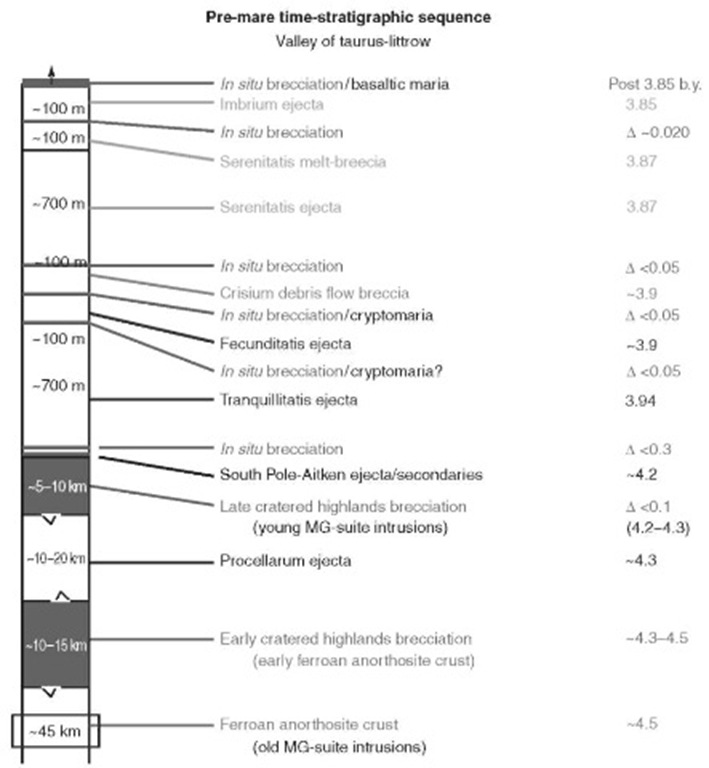
Plate 11. Premare time-stratigraphic sequence—Valley of Taurus-Littrow.
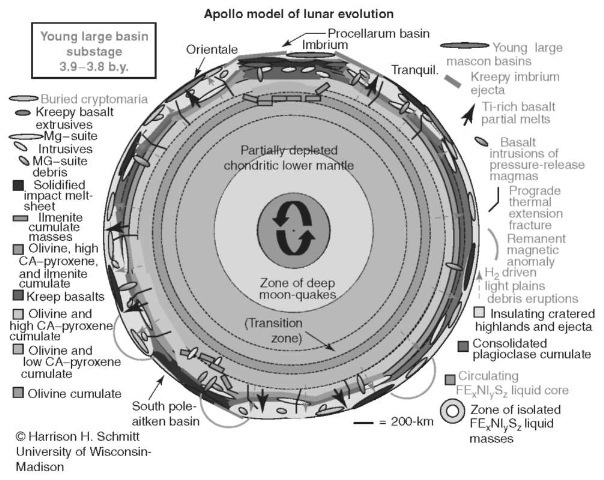
Plate 12. Apollo model of lunar evolution—Young Large Basin Substage 3.9-3.8 b.y.
One of the questions raised about the crystalline melt breccias (442) investigated at Stations 6 and 7 in the Valley of Taurus-Littrow relates to the vesicles or smooth-walled holes they contain. The holes formed when the breccia was partially molten and an immiscible fluid phase separated and coalesced to shape them. Elongation of the vesicles indicates that the melt breccia was still flowing when this phase was present but not at temperatures sufficient to melt all silicate clasts. Vesicles also formed in the more solid rock in contact with the melt breccia. Vesicles are common phenomena in terrestrial lavas where a variety of volatile components, particularly water and carbon dioxide, are available to form the immiscible fluid. The chemical nature of the vesicle phase in lunar breccias, however, is constrained (1) by the lack of evidence that water or carbon dioxide ever existed in these lunar rocks, (2) by the absence of any discernible alteration of the minerals lining the vesicles, and (3) by the absence of anomalous mineral precipitates on the vesicle walls. A number of lines of reasoning suggest that the apparently inert fluid in question consisted largely of hydrogen and/or carbon monoxide; some helium and volatile nitrogen and other carbon compounds were possibly included. Throughout the formation of the Cratered Highlands, much of the pulverized ferroan anorthosite would have been as fine as the present-day surface regolith due to oversaturation with impacts smaller than those that formed the saturation size, 60-70 km diameter craters. This fine regolith would have been exposed to the solar wind of that time. Today, the solar wind is 96% protons (443) and may have been much more intense during the early history of the solar system, although the particularly intense T-tauri phase of solar evolution probably preceded the Cratered Highlands Stage (~ 4.4—4.2 b.y. ago) of lunar history (444,445). Plagioclase, the mineral phase comprising about 85% of the lunar highlands, is a mineral known to be capable of incorporating hydrogen ions in its crystal lattice (446). Epithermal neutron spectra from Lunar

Figure 12. The large boulders investigated at Station 6 at the base of the North Massif. The five boulders accessible for examination and sampling are apparently all part of one boulder that broke apart as it came to rest after rolling ~1.5km down the side of the valley.
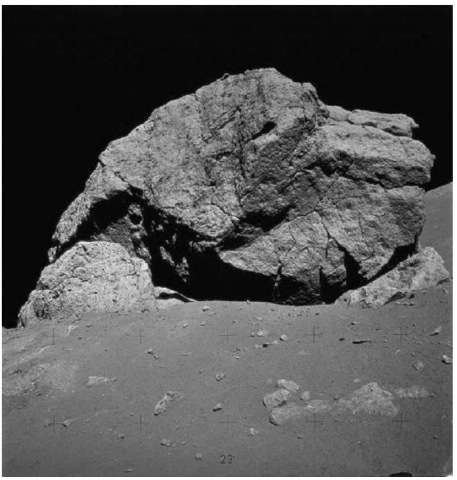
Figure 13. Contact between tan-gray, vesicular impact melt breccia (on the left) and blue-gray, clast-rich, nonvesicular impact breccia (on the right) in the boulder at Station 6 shown in Fig. 12 (courtesy of NASA).
Prospector (447) indicate an average of about 30 ppm hydrogen in the present-day highland regolith (448). Thus, there is the potential for retaining significant hydrogen, as well as impactor-derived volatiles, throughout the fine portions of the crustal megaregolith. Until it is possible to sample the fines of the deep megaregolith directly, it will remain uncertain whether there was sufficient solar wind exposure during the Cratered Highland Stage to provide the volatiles necessary to create the observed vesicles. A possible alternative source of vesicle-forming fluids may be the volatiles derived from impactors or material volatilized upon impact; however, most evidence indicates that such extremely high temperature material is lost to space (449-451) or would be expected to condense very quickly into solid material. Thus, solar wind hydrogen and lesser amounts of solar wind helium and carbon monoxide from the fine fraction of the megar-egolith could be incorporated into impact melts and form the observed vesicles. Such hydrogen also may be mobilized in the crater ejecta, lowering the overall viscosity and contributing to the mobility of debris flows (452).
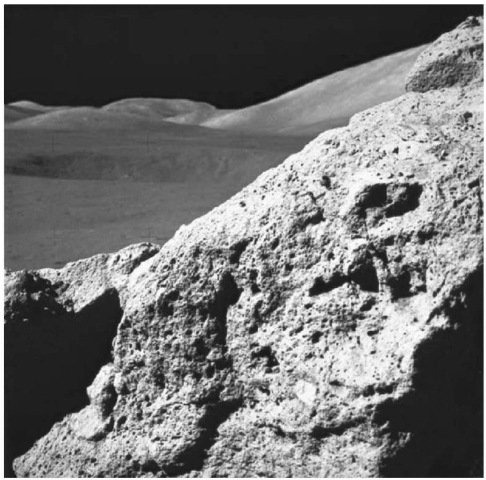
Figure 14. Tan-gray, vesicular impact melt breccia of the boulder at Station 6 shown in Fig. 12 (courtesy of NASA).
An additional effect of young, large basin formation appears to have been the creation of bright swirls (Fig. 16) antipodal to at least the four youngest basins, Crisium, Serenitatis, Imbrium, and Orientale (453). Another, less precise correlation, may be the large bright swirl, Reiner Gamma, which is roughly antipodal (approximately 50°W, 20°N) to the young basin, Tsiolkovskiy. The extensive region of swirls east of the Crisium basin and antipodal to Ori-entale were observed and photographed in detail during the Apollo 17 orbital mission. Bright swirls have no apparent topographic relief or texture, are diffusely bordered, and have local dark cores. There have been recent suggestions that bright swirls represent variations in proton-induced darkening of surface materials. These variations might be caused by deflections of solar wind associated with remnant magnetic anomalies that are also roughly antipodal to at least four and possibly six of the young basins (454-456). Alternatively, the swirls may be the result of an internally originated process that causes changes in the relative abundance of fine and coarse particles in the regolith (more coarse particles give a brighter albedo). This change may possibly be related to gas flow from the crust or deeper interior of the Moon that moves fine particles upward to the surface in response to seismic shaking at antipodes from large impacts. Such an origin would account for the reported lower maturity index for the Reiner Gamma swirl relative to the host mare basalt (457), although magnetization of thick, underlying Imbrium ejecta has also been suggested as the basis of this and two other swirls in the region (458). On the other hand, the antipodal association of magnetic anomalies, if genetically related to basin formation, would provide a constraint on the duration ofa past lunar dipole field. As anomalies do not appear to be antipodal to the old large basins and are of lower intensity antipodal to Orientale, then the dipole may have been active only between about 3.92 and 3.80b.y., the span of apparent ages of these young basins. If this suggestion survives further scrutiny, these dates may indicate the approximate times of lunar core formation and termination of core circulation, respectively. If it took about 600 m.y. for the FexNiySz liquid that formed the lunar core to migrate through the lower mantle and coalesce as a core, then this would be further support for the hypothesis that the whole Moon never melted during the Magma Ocean Stage. Otherwise, FexNiySz liquid would have formed a core nearly simultaneously with melting of the whole Moon.
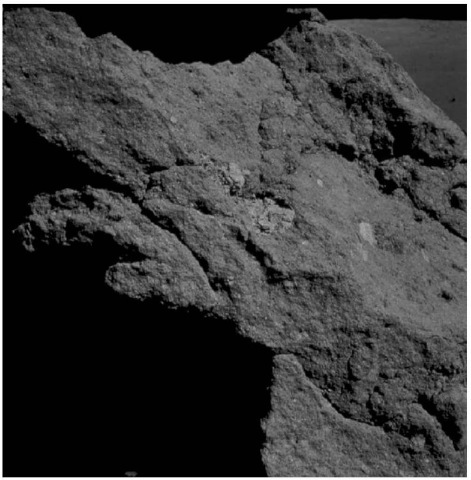
Figure 15. Blue-gray, clast-rich impact breccia of the boulder at Station 6 shown in Fig. 13.
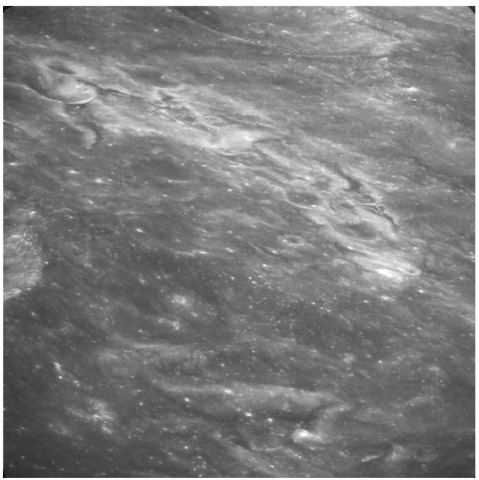
Figure 16. Light-colored swirls on the surface of the farside of the Moon, east of the Smythii Basin and antipodal to the Orientale Basin.
Basaltic Maria (Stage 5—Upper Imbrium). Considerable evidence exists of eruptions of basaltic lavas on the Moon (Plate 13) as early as 4.2 b.y, the cryptomaria (459), and as late as 1.3 b.y. in Oceanus Procellarum (460). The majority of the partial filling of many of the large basins by mare basalt (see Fig. 11), however, particularly on the nearside of the Moon, appears to have begun about 3.8 b.y. ago and lasted for about 800 m.y. years. This period constitutes the bulk of the Basaltic Maria Stage of lunar evolution (461-463) (Fig. 17). Recent estimates of the volume of mare basalt range up to 107-km3 (464), and the mean volume per eruption was about 200-km3 (465). These volume estimates do not include potentially abundant intrusions in the pervasively fractured lunar crust. Hidden intrusives in the thick crust may account for the “missing” mare basalt on the lunar farside. The fundamental characteristics of the samples of mare basalts collected by the Apollo astronauts are their chemical and mineralogical diversity (466—469). The mare basalt sample suites from the Apollo 12 and Apollo 17 sites, however, contain many samples that appear to be largely derived from one or two individual flows or cooling units (470-472) and are discussed in more detail later. The variety of mare basalt compositions attests to the comparable variety of depths, mineral assemblages, and degrees of partial melting involved in the lunar mantle, as the mare basalt magmas formed (473,474). This variety probably was further enhanced by the differing degrees of internal differentiation that resulted from fractional crystallization and devolatilization during ascent and solidification which it has been noted, also took place in the Apollo 12 basalt flows (475) (Plates 14-16).

Plate 13. Apollo model of lunar evolution—Basaltic Maria Stage 3.8-3.7 b.y.
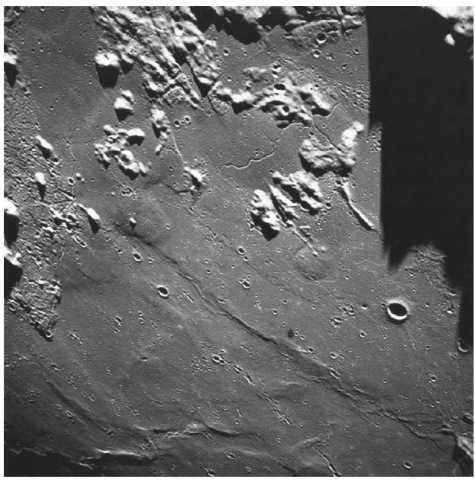
Figure 17. Mare structures near sunrise on the mare basalt surface of the eastern Imbrium Basin.
The insulating nature of the Cratered Highlands and the heat sources in KREEP-related intrusives within and beneath the crust would have resulted in a downward wave of partial melting, progressing through the Magma Ocean cumulates of the upper mantle. This constitutes the simplest and currently most plausible scenario for the generation of mare basalt magmas during their peak eruptive period. Additional sources of heat would have included interstitial ra-dioisotopes within the cumulates. Partial melting at increasing depths would partially reverse the sequence of cumulate formation in the cooling Magma Ocean, initially producing primary magmas rich in titanium and KREEP-related components at about a 200-km depth, followed by melting at increasing depths to below 400 km (476,477). These would be reflected in magmas that had progressively less titanium, less KREEP-related components, and more magnesium as deeper olivine and orthopyroxene-rich cumulates reached equilibrium with the very earliest partial melts derived from interstitial plagioclase, ilmenite, and other minor minerals. This sequence can be verified only in a general sense; the oldest samples of mapped lavas are titanium-rich (Apollos 11 and 17), and the youngest are magnesium-rich (Apollos 12 and 15 and Lunas 16 and 24). Analysis indicating that platinum group elements have higher concentrations in the older, titanium-rich basalts than in the younger, magnesium-rich basalts, is consistent with this sequence as well. Due to the early separation of iron-rich liquid from the Magma Ocean (see the previous discussion of the Magma Ocean Stage), the remaining siderophilic platinum group elements, most of which would have gone into the iron-rich liquid, would have been reconcentrated in the residual liquid from which ilmenite ultimately crystallized (478). Clearly, there are great uncertainties in attempts to correlate source region compositions and ages among various maria on the Moon. For example, in the Oceanus Procellarum maria west of Imbrium there appears to be a reversal of the sequence of old and titanium-rich to young and magnesium-rich. Many of the youngest lavas in Oceanus Procellarum that have been identified by remote sensing and dated by crater statistics (479) are also titanium-rich. This reversal may be explained by an earlier migration of dense ilmenite cumulates to deeper portions of the mantle in response to the disruption of the Procellarum basin-forming event. Such a gravitational destabilization of ilmenite cumulates has been suggested for the entire Moon (480); however, the distribution and ages of Ti-rich mare basalts are not consistent with this more global hypothesis.
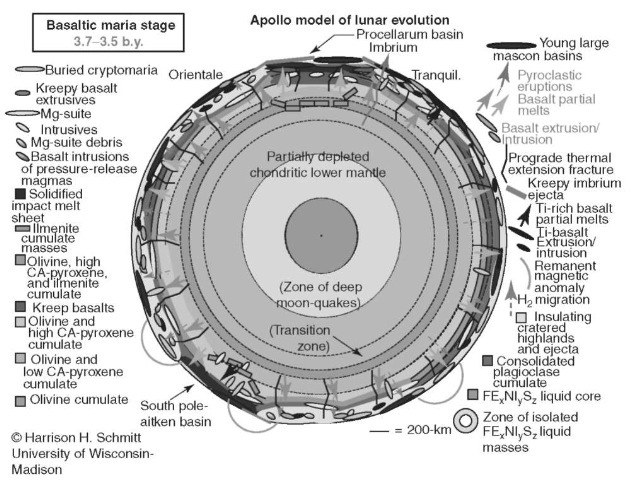
Plate 14. Apollo model of lunar evolution—Basaltic Maria Stage 3.7-3.5 b.y.
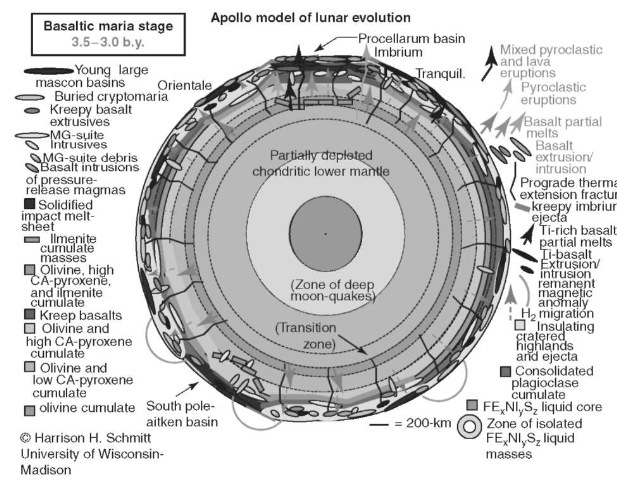
Plate 15. Apollo model of lunar evolution—Basaltic Maria Stage 3.5-3.0 b.y.
Samples of basalts in the older to younger age sequence, Apollo 11 > Apollo 17 > Luna 16 > Luna 24/Apollo 15 > Apollo 12 (481-483), appear to follow this melting sequence scenario reasonably well. Greater amounts of incompatible, KREEP-related elements are also noted in older basalts (484) due to the close association of late ilmenite cumulates with the residual melt of the Magma Ocean. Although Apollo sample analyses suggest a bimodal distribution of titanium in mare basalts, remote sensing data indicate that the majority of mare surfaces show a few percent TiO2 and smooth decreases in abundance on either side of this peak (485). Except for the old titanium-rich basalts noted, variations in major element compositions, particularly in titanium, potassium, and aluminum, can be attributed to fractional crystallization of basaltic magmas and/or melting varying proportions of ilmenite-, KREEP, and plagioclase-bearing interstitial material, respectively, in the source cumulates (486-488). Significant assimilation of crustal material is ruled out by geochemical and isotopic considerations (489). Rare-earth patterns also follow a compatible sequence; the greatest europium depletion occurred in the oldest primary mare magmas (490), magmas produced from cumulates subject to the longest interval of plagioclase crystallization. A proposed alternative scenario for producing the primary magmas for the basaltic maria through partial melting of a hybridized upper mantle plus assimilation of various materials (491) suffers from inconsistency with the apparent depths of partial melting as a function of time. Also, models for mantle hybridization (492) are inconsistent with the concept of the generally composi-tionally concentric structure of the mantle discussed before and with the improbability of overturn in the lunar mantle when fully solidified. The apparent exception to the lack of mantle hybridization, as noted before, consists of the region beneath the Procellarum Basin and possibly beneath the South Pole-Aitken Basin. Very large basin-forming events would have had the potential to destabilize the underlying mantle though pressure-release melting and may have allowed relatively dense ilmenite-rich cumulates to migrate downward.
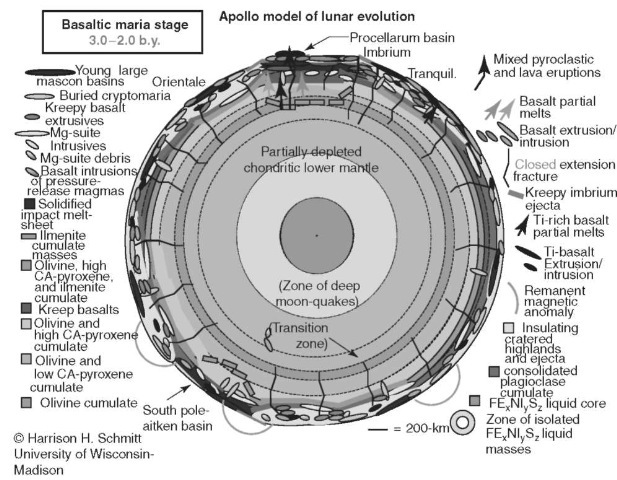
Plate 16. Apollo model of lunar evolution—Basaltic Maria Stage 3.0-2.0 b.y.
Apollo samples and age estimates by crater statistics suggest that surface flows during the main phase of mare basalt eruption appeared first in the Serenitatis-Tranquillitatis region of the Moon. This spatial association probably exists for three reasons. First, after the formation of the Procellarum Basin and before the Serenitatis and Tranquillitatis events, as discussed previously, a thick portion of insulating megaregolith and ejecta lay over this region, accelerating reheating of the mantle. Second, due to the offset of the Moon’s center of mass from its center of figure toward this region (493), a selenopotential low existed that facilitated magma access to the surface. Third, younger magmas would be forced progressively away from the area of preceding eruptions as they encountered a largely permeated and sealed crust. Although the distribution of basins and highlands would perturb this idealized pattern, some indications of a roughly concentric color and age pattern of mare distribution around the selenopo-tential low have been observed (494,495). On the other hand, by 3.92 b.y. ago, the beginning of the Young Large Basin Substage, fractional remelting of the outermost cumulates of the Magma Ocean probably had progressed in many regions, if not globally, to the point of incipient eruption. The Serenitatis event (3.87 7 0.08 b.y.) and other large events on the nearside of the Moon may have accelerated regional mantle melting by the release of lithostatic pressure resulting from the instantaneous removal of 10-20 km or more of crustal material (496). No specific evidence, however, indicates that this significantly affected the eruptive history of the maria (497). Elimination of most of the initial pressure change might have occurred through rapid rebound of the basin floors as partially fluidized mantle material moved inward and upward to compensate (498). Additionally, nearly contemporaneous movement of large fault blocks of basin rim masses into the transient crater cavity may have taken place (499).
Nonetheless, the oldest known lavas spatially associated with the Serenitatis basin crystallized about 3.82 7 0.25 b.y. ago (500). These old, high-titanium lavas were sampled during Apollo 17 at the rim of Camelot Crater (Fig. 18). Because these mare basalts lie above Imbrium ejecta deposits and Apollo 14 and 15 samples date the Imbrium event at 3.85 7 0.03 b.y. ago (501), the oldest basalt ages can be constrained even more to about 3.82 + 0.26 b.y. The Taurus-Littrow lava, or rather the regolith formed on them, is contiguous with a dark blue-gray annulus about 50 to 100 km wide around Serenitatis and is roughly contiguous with the titanium-rich basalts of Mare Tranquillitatus to the south The annulus of dark blue-gray regolith underlies younger mare basalts covered with brown-gray regolith in the central portion of the southern Se-renitatis Basin (502,503), regolith low in titanium, as determined by remote sensing (504). The younger, central basin lavas may be represented in the Apollo 17 sample suite by small fragments of low-titanium basalt in the regolith that have ages of 3.74 + 0.20 b.y. (505). The most common types of titanium-rich basalts (Types A and B) sampled in the Valley of Taurus-Littrow are of a differentiated continuum between high-titanium, olivine-rich basalt and a low-potassium, olivine-poor basalt that can be produced by fractional crystallization of a single magma (506). Consideration of the depths of the craters that excavated the Type A and B samples suggests that these basalts represent most ofthe upper 100-150 m of the basalt section. Active seismic measurements made just after the Apollo 17 mission determined that approximately 1.175km of basaltic rock partially filled the valley (507). In situ gravity measurements showing a basalt depth of ~ 1.4 km (508) roughly confirms the seismic estimate. No direct field evidence exists for the thickness of individual flows in this basalt section. The rate of extrusion may have been high enough that individual eruptions coalesced to create a few thick cooling units, possibly only one, as suggested by the chemical trends between basalt Types A and B. Field observations support this conclusion in that they disclosed only limited textural or mineralogical variability among the basalt boulders other than in vesicle concentration and grain size. The seismic profiles further suggest only two major units, one 248-m thick zone that had a seismic velocity of 250 m/s underlain by a 927-m thick zone that had a velocity of 1200 m/s, both consistent with known basalt velocities (509). The upper unit may be an intensely fractured portion of a single cooling unit because the profiles were measured largely under the highly cratered central portion of the valley. In contrast to these apparently thick Apollo 17 basalt units, samples from around craters in the basalt flows at the Apollo 12 site provided conclusive field and chemical evidence of fractional crystallization in flows only a few tens of meters thick, primarily through the settling of olivine (510,511). Olivine frac-tionation also seems dominant in the differentiation of the apparently much thicker Apollo 17 flows; however, ilmenite, armalcolite [(Mg,Fe)Ti2O5], and chromian spinel may be involved as well (512). On the other hand, many mare basalt flows extruded late in other eruptive areas appear to be only 10-60 m thick (513). Photographs by the Apollo 15 crew of flows exposed in Hadley Rille (514), photogeologic evidence of relatively thin flows at the surface of other basins, and the thin flow that must have protected the integrity of the orange volcanic glass deposit in Taurus-Littrow (515) indicate that this often has been the case.

Figure 18. Mare basalt boulders at Station 5 on the rim of Camelot Crater excavated from a depth of about 150 m. The author is moving toward the Lunar Rover.
Apollo 17 radar data taken from orbit (516) are consistent with a 3-km thick basalt section in the central portion of the southern Serenitatis Basin. Analysis of impact craters penetrating this mare (517) gives an estimated thickness of 4 km. A number of factors indicate that the lunar basaltic eruptions that created the maria in general occurred at high rates from many centers across wide regions. Such rapid and pervasive eruptions would result in dense plates and possibly thick cooling units in the central portions of confining basins. For example, the innumerable deep fractures in the crust and upper mantle associated with Serenitatis and previous impacts provide a vast number of potential magma conduits. Gravity one-sixth that of Earth’s and a lunar magma viscosity 10 times lower than that of the average terrestrial basaltic magma will result in a flow rate from source regions possibly 50% faster than that in Earth (518). This may lead as well to a propagation rate in the crust as much as ten times faster. The increase in volume of a partial melt compared to its crystalline equivalent would have created overpressures and/or buoyant forces (519) necessary to drive magma from the mantle and into and through the crust, accompanied by intensified microfracturing and refracturing of the lower crust. A significant likelihood also exists that the crust was in overall tension during the Basaltic Maria Stage as a result of volume increase due to thermal expansion and partial melting of the upper mantle. Such tension would have tended to keep fractures open until filled by solidified magma. All of these factors may have produced a volume of intrusive basalt dikes beneath the central portions of mare basins like Serenitatis that is great enough to contribute to the spatially associated mascon. If such a mass contribution is significant, then the degree to which modeling of mascons depends on an elevation of the crust-mantle boundary would be correspondingly reduced. The fact that the youngest flows in a given region are low volume flows can be best explained by decreasing magma production and/or the constriction or closing of most conduits by preceding eruptions. Many late eruptions, particularly of regional deposits of pyroclastic volcanic glasses, are closely associated with large, graben-forming fractures related to major basin margin structures. The very deep source regions indicated for such glasses and their associated volatiles strongly suggest that these fractures penetrate more than 500 km into the lower mantle (520), again indicating an upper mantle in structural tension at the time of eruption.
Major basalt units in the Apollo 17 suite are vesicular, as are basalts from other mare landing sites. The variability of associated mineral linings and phase equilibrium implications of these relics of an immiscible fluid phase were first studied in Apollo 11 basalts from Tranquillity Base (521). As in crystalline melt breccias, is a likely candidate for a vesicle fluid phase, although carbon monoxide is another strong possibility (522-524). Unlike the probable solar wind origin of the hydrogen in melt breccias, however, hydrogen or carbon monoxide in the mare basalt magmas would need to be derived from primordial sources (525). In the case of hydrogen, primordial water would be decomposed by downwardly migrating FexNiySz liquid separated from the Magma Ocean and would produce FeO and hydrogen. The total absence of any indication of water associated with the vesicle fluid phase demonstrates that all primordial water in the source materials for the Magma Ocean has been lost to space or has decomposed. Further, the lack of evidence that water was associated with the adsorbed volatiles in pyroclastic volcanic glasses indicates that no water remains in the lower, more primitive mantle and supports the hypothesis of a broadly disseminated migration of FexNiySz liquid through this material to form the lunar core. The presence of hydrogen as a component of lunar magmas would affect other aspects of magmatic activity, including, density, viscosity, fractional flotation of minerals adhering to vesicle walls, and the dynamics of late-stage eruptions from cooling intrusives.
Fluorine is slightly concentrated on the walls of basalt vesicles relative to the rock as a whole (526). Fluorine constitutes an important component of the volatile fraction of the orange and green volcanic glasses, so a broader attempt to characterize the vesicle fluids in lunar basalts might be of significant interest.
Regional dark mantle deposits have been mapped around the southern edge of the Serenitatis Basin (527,528) (Fig. 19) as well as in many other locations on the Moon (529). These deposits and similar pyroclastic materials sampled by Apollo 17 characterize late-stage mare volcanism at the edges of a few other large basins, including Imbrium (green volcanic glasses sampled by Apollo 15). As previously discussed, the volcanic glasses associated with these deposits and found ubiquitously as a component of mare regolith at all of the Apollo sites have continued to grow in significance relative to the origin, evolution, and internal structure of the Moon (530,531). The continuing interest in such glasses was catalyzed by the Apollo 17 discovery of the nearly pristine orange volcanic glass and its black, partially devitrified equivalent in the rim of Shorty Crater (532,533). Table 3 summarizes the geologic history of the area near Shorty Crater. Another type of basalt sampled in the Valley of Taurus-Littrow (Type C), a very high titanium, vesicular olivine-rich basalt, apparently formed a protective unit above the original, pre-Shorty orange and black volcanic glass deposit. Type C basalt has an unusually low Ba/Rb ratio that also distinguishes it from other basalts in the valley (534). Some such lava flow necessarily covered the deposit at Shorty soon after it was formed during a pyroclastic eruption (535) about 3.48 7 0.03 b.y. ago (536), or about 300 m.y. after the major mare basalt eruptive activity in the valley. Orange glass argon exposure ages of 30 7 6 m.y. (537) indicate that the original pyroclastic deposit lay unprotected on the Moon’s surface for about that length of time. Further, cosmic ray track data indicate that the event that formed Shorty and exposed the orange glass occurred between about 107 3 (538) and 19 m.y. ago (539). This Type C basalt made up a unit of limited lateral extent because samples of it were obtained only at Station 4 on the rim of Shorty Crater (540). No other evidence of protected orange glass was observed, even though beads of this glass are important constituents of the valley regolith (541). The Type C unit also was apparently quite thin as it, several meters of the underlying pyroclastic deposits, and a meter or so of light mantle debris (see below) must fit into a section about 14 m thick, the depth of Shorty Crater below the precrater surface. No pyroclastic material was observed on the floor of Shorty, only large blocks of fractured basalt. Most of the Type C basalt would have been pulverized and incorporated in the approximately 10 m of regolith developed in the valley during the 3.5 billion years since its eruption.
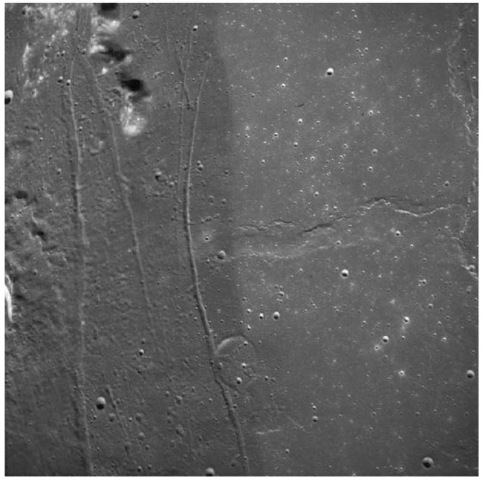
Figure 19. Regional deposit of dark mantle material near the southwestern edge of Serenitatis. Orbital observation during the Apollo 17 mission indicated that these deposits contain extensive layers of orange, red, and black glasses.
These orange pyroclastic glasses (see Figs. 6 and 7), independent of their adsorbed volatiles, appear to have originated from melting of the deep portions of the upper mantle, possibly as deep as 400 km or more below the surface (542,543). Even deeper origins are indicated for the low-titanium green glasses sampled by Apollo 15 (544). The small europium depletion in the Apollo 15 green volcanic glasses (545) suggests a deep (early) cumulate source region less affected than mare basalt source regions by the loss of europium during plagioclase separation from the Magma Ocean. On the other hand, the larger europium depletion and generally higher rare-earth concentrations in the Apollo 17 orange glasses suggest a relatively shallow (late) cumulate source region from which plagioclase has crystallized. Clearly, there is much more to be learned from the pyroclastic glasses. For example, the high-titanium orange glass turned out to be high in iron and magnesium relative to high-titanium mare basalts (546), also consistent with a source distinct from those basalts. Interpretations of analyses of trace elements (547) indicate that the source regions for some pyroclastic glasses have some chondritic characteristics with regard to these elements and include garnet as a mineral phase. These data suggest that some of the source regions of the pyroclastic glasses lie below 550 km, the apparent base, on seismic grounds, of the largely or entirely molten Magma Ocean (548,549). Further, the light gray regolith on either side of the orange glass deposit, apparently altered from the darker gray of the nearby regolith due to volatile migration, contains unusually high Na (550), which is otherwise depleted in crustal mare basalts relative to carbonaceous chondrites (551).
Table 3. Sequence of Geologic Events in the Vicinity of Shorty Crater
Table 3. (Continued)
After mare basalt eruptions, and associated with many if not most eruptions of regional pyroclastics (552-554), normal faulting (555) occurred in nearby mare-filled basins. These faults produced many long, often arcuate graben valleys (556) (see Fig. 19). As discussed before, this phenomenon suggests that the stress regime of the lunar crust was tensional during the Basaltic Maria Stage and for some time before. Such a tensional stress field would be expected because thermal expansion and partial melting of the upper mantle began soon after the formation of the Cratered Highland Stage’s insulating megaregolith. The more slowly expanding lower mantle may have maintained this global tensional field, long after heating and partial melting of the upper mantle ceased due to mare basalt eruption and consequent heat transfer to the surface. Long duration crustal tension may explain the existence of a structural moat or trough rather than the normal talus apron between the base of the Apollo 17′s South Massif and the mare basalt fill in the Valley of Taurus-Littrow (557). A sporadic but continuous widening of the fault boundary that defines the south side of the valley (558) apparently has provided space for talus accumulation. Later regional relaxation of crustal tension would have contributed to the formation of the abundant mare ridges (559). These ridges, also called wrinkle ridges, constitute common features on the exposed surfaces of the lunar maria (560). They are apparently produced by regional compressive stresses associated with eruptive episodes of basalt of an age younger than the lavas affected or with the cooling of the upper mantle after eruptive activity ceased in a given region. The east-west to north-south Jefferson-Lincoln-Lee scarp that crosses the lower slope North Massif and the Valley of Taurus-Littrow appears to be such a ridge. It probably expresses the trace of a thrust fault (561). The absence of strike-slip faults (562) in this region as well as elsewhere on the Moon probably reflects the very low shear strength of the intensely fractured and brecciated outer lunar crust. That some shear stress can be present in the Moon is indicated by local en echelon displacement of a few graben valleys (563). The greater curvature of the Moon relative to other planets may also contribute to the lack of significant regional shear stress (564).
Mature Surface (Stage 6—Pre-Nectarian-Present). Maturation of the surface of a lunar geologic unit begins with stabilization of the unit’s upper surface. Primary and secondary impacts and space radiation cause some degree of modification on every surface formed on the Moon, however transitory its exposure may be to the space environment. A quantitative maturity index has been developed (565); however, it has become increasingly clear that factors other than age can effect the measured ”maturity.” Although the index is useful in comparing similar units, relative iron, and titanium contents of the original materials (566), and initial particle size and volcanic glass content (567) will affect its values significantly. For most of the lunar highlands, there was a continuous process of megaregolith development followed by normal regolith development beginning with the formation of the first coherent solid surface on the Magma Ocean. At a more detailed level, regolith development began region by region, area by area with the emplacement of the last ejecta derived from a large basin-forming event or from a crater that fully penetrated older regolith. Similarly, for the lunar maria, regolith development began basin by basin with the solidification of the last mare basalt unit at the surface. Thus, the Mature Surface Stage for the lunar maria overlaps much of the Large Basin Stage on the highlands and began in a staggered sequence between 3.8 and 3.0 b.y. ago on most of the maria, depending on the age of flow surfaces.
Regolith makes up the dominant maturation product (see Figs. 4, 8, 12 and 18). This layer of pulverized debris is developed largely through impacts, the largest producing fairly sharp, irregularly cupped contact on fractured bedrock. The regolith constitutes the upper tens of meters of surface materials in the highlands; however, over the oldest of the lunar maria, such as at Apollo 11′s Tranquillity Base, the regolith reaches an average maximum depth of only about 6 m. Near contacts between the maria and steep highland slopes or where pyroclastic glasses have been added to the surface ofearlier formed regolith, the overall depth of largely fine-grained debris increases. This has been studied best in the Valley of Taurus-Littrow. Here, highland debris from the North and South Massifs and glass beads from pyroclastic deposits have added several meters of thickness to the regolith (568). Cosmic rays and solar wind particles also modify the lunar regolith. Cosmic rays produce a variety of spallation isotopes useful in measuring the length of time materials have been exposed at or near the lunar surface (569). They induce the production of neutrons whose energy or temperature can be measured in lunar orbit and used to determine remotely the concentrations of some interacting elements in the regolith (570). High-energy solar wind ions, largely hydrogen and helium but contianing significant carbon and nitrogen and minor noble gases as well, stream continuously from the sun, guided by solar magnetic lines of force. The flux of solar wind ions at the lunar surface varies with the quantity ejected from the Sun and because of interactions with Earth’s magnetosphere. Upon impinging on the lunar surface, these ions are embedded continuously in the near surface mineral and glass constituents of the regolith, are partially released later by micrometeoroid impact and diurnal heating, and are partially retained by burial under ejecta from impacts. To some degree, released species will be entrained in the passing solar wind (”pickup ions”) and are either lost entirely or reimplanted elsewhere on the Moon. For any given regolith deposit, a steady state of solar wind concentration develops that depends on the overall length of exposure, so that the measured amount of retained solar wind increases roughly with the age of the underlying unit. A definitive model of this overall process has not been published; however, the analysis oflunar soils has disclosed the approximate steady-state concentrations ofsolar wind volatiles in samples and cores from the various Apollo landing sites (571,572). Most sampling, bagging, transporting, splitting, and distribution of Apollo samples was not designed to prevent the loss of contained solar wind volatiles. As a consequence, the vast majority of quantitative measurements of solar wind components in the lunar regolith samples must be viewed as minimum amounts, possibly in error by as much as 50 to 100%.
Evidence is strong that solar wind hydrogen and helium are retained selectively by feldspar and ilmenite, respectively. In the earlier discussion of the origin of vesicles in crystalline melt breccias, it was noted that epithermal neutron spectra, measured by Lunar Prospector (573), indicate variations in concentrations of protons (hydrogen) in the lunar regolith. Significant concentrations by factors of 2-3 exist in the lunar maria relative to the highlands. The feldspar crystal lattice can hold hydrogen in a cation position (574); however, the specifics of retention in lunar feldspars have not yet been addressed. Hydrogen’s affinity for titanium, present in the mineral ilmenite [FeTiO3] in most maria, may contribute to the retention of solar wind hydrogen in basaltic regolith. The Prospector data also show that hydrogen, specifically protons, are concentrated by factors of 3-10 at the lunar poles, apparently related to the generally colder regolith and to approximately 20,000 km2 of permanent shadow in those two areas (575,576). The temperature of surfaces in permanent shadow is a constant — 230°C in contrast to the maximum daytime temperature at the equator of + 123°C (577). The Prospector Team (578) and others using data from Clementine (579) interpreted the epithermal neutron spectra to indicate the presence of large quantities of water ice. The Clementine data have been disputed vigorously (580). Still others have suggested that most if not all the signal in the polar regions is related to solar wind hydrogen (581,582). Water ice might be deposited as a consequence of cometary impacts on the Moon, as predicted theoretically (583). The interpretation of the Lunar Prospector neutron spectrometer data indicating water appears premature, however, in the face of the proven presence of more than 100 ppm solar wind hydrogen in many soil and regolith breccia samples (584). Solar wind hydrogen would also be concentrated and preserved as a distributed regolith component in the colder polar regions as well as in permanent shadow. In permanent shadow, no significant amount of implanted solar wind hydrogen would be lost to thermal cycling and both primary and pickup ions would be continuously deposited in such areas, albeit at a slower rate due to geometric factors. Further, a continuous blanket of cometary water ice, precipitated on rare occasions in permanent shadow, would remain subject to micrometeoroid erosion comparable to that which gardens the upper few centimeters of the regolith approximately every 10 million years (see data summarized in Table 3). Unless covered by protective ejecta from impacts or deposited in one ofthe few extremely deep craters near the South Pole, as now postulated by the Lunar Prospector Team (585), the water ice blanket may erode and be dispersed in a geologically short interval. Some water ice and other cometary volatiles may be preserved beneath scattered ejecta blankets or in deep craters in permanently shadowed areas, depending on the frequency of cometary impacts relative to the rate of water ice erosion. Solar wind hydrogen, however, probably accounts for most if not all of Lunar Prospector’s epithermal neutron signal.
The high-titanium regolith in the Valley of Taurus-Littrow has helped to quantify the correlation of solar wind helium content with TiO2 in Apollo samples of regolith derived primarily from mare basalt. This relationship had been well-documented in samples from other Apollo sites (586). Because ilmenite is the only significant titanium mineral in the regolith, it appears to accommodate helium in its lattice better than other minerals and glasses. Helium release signatures from lunar samples containing ilmenite have been duplicated in terrestrial ilmenite irradiated with helium ions at solar wind energies (587). Significantly, the light isotope of helium, 3He, holds great promise as a lunar resource export to supply future fusion power plants on Earth (588,589). Although the regolith in the valley of Taurus-Littrow has concentrations of 3He, early resource production probably would concentrate on much larger areas in the Mare Tranquillitatis (590,591). The 2000-km long volcanic province of central Oceanus Procellarum constitutes another high-titanium region of the Moon; however, until direct evaluation of the strength of the titanium-helium correlation can be made specifically for this province, Tranquillitatis probably will remain the preferred target area for early production. If it is shown that the proton signal at the lunar poles is largely the result of a 3- to 10-fold concentration of solar wind hydrogen, then helium may be concentrated there as well. Whether such a concentration advantage can offset the higher cost of mining, living, and transportation inherent in any resource recovery at the lunar poles remains to future study.
During the Mature Surface Stage, impacts continued and declined to approximately present frequency levels (592) with some recently detected variability (593). They did not, however, change the face of the Moon significantly. Three billion years ago, the full Moon would have looked very familiar to a time traveler from our day. The type example of one of the few major impacts of this stage has been that which formed the 95-km diameter crater Copernicus (594,595) about 0.85 b.y. ago (596). Secondary projectiles from another such crater, Tycho, appear to have formed the cluster of craters in the central portion of the Valley of Taurus-Littrow and triggered the avalanche or landslide that produced the light mantle deposit (597) (see Fig. 3). This association, if valid, places an age of ~ 100 m.y. on the Tycho event (598). The plume-like avalanche deposit, essentially identical mineralogically and chemically to the regolith on the slopes of the South Massif, was investigated and sampled at Stations 2, 2A, and 3. An avalanche-related origin of the light mantle deposit is supported by an apparent vertical separation of rock fragments by size within the deposit (599). In situ screening of near-surface debris from both South Massif talus and light-mantle, produced a significantly lower frequency of rock fragments larger than 2 cm in samples from the light mantle. Additionally, visual comparisons of the size of boulders excavated by impacts into the deposit correlated roughly with the diameter of craters, and thus with the depth of excavation. Sorting by size and the potential availability of hydrogen released by particle interaction in the flowing feldspathic regolith further suggests that the avalanche was gas lubricated. The liberation of solar wind gases by particle abrasion in regolith samples was demonstrated during soil mechanics experiments on returned samples (600).
Possible Implications
Apollo 17 had both the privilege and the sadness to be the capstone on humankind’s first venture into deep space. The privilege came in contributing to the reemphasis of the potential of free men and women when given a challenge they believe must be met. The sadness lay in not continuing to amortize the investment of human lives, families, energy, and resources that made Apollo possible. Science, however, owes much to the explorations of the Moon and became the second major objective of this technological race into the future. As a consequence of obtaining an understanding of the evolution of a second planet, we now can look at other terrestrial planets with far greater insight than ever would have been possible otherwise (Fig. 20). The record of impact activity on the Moon, particularly that between about 4.4 and 3.8 b.y. ago, represents a period of Earth history that spans the time when complex organic molecules became replicating life forms (601-603) and continents began to form. During the first 200 m.y. of this period, the Moon’s dry anorthositic crust was saturated with impacts capable of forming craters 60-70 km in diameter. On Earth, the pulverized and partially vitrified crust created by a similar saturation would have continuously reacted with water to create a wide spectrum of clay species (604), whose crystal structure may have been important as templates for organic synthesis. During this same interval, two and possibly more very large impact basins formed on the Moon; their terrestrial equivalent would have been larger and had thick interior melt-sheets. The differentiation of these melt-sheets would have yielded silica-rich disks thousands of kilometers in diameter and possibly tens of kilometers thick that became potential seeds for the aggregation of early continents. The existence of a continental crust on Earth has now been placed at least at 4.3 b.y. ago (605,606) and consistent in time with the formation of very large lunar basins. The next 400 m.y. on the Moon saw about 50 large impacts that created basins at least 300 km in diameter plus many more smaller. On Earth, a much larger number of similar events may have delivered additional organic components as well as augmented the initial continental material. The global effect, however, of such highly energetic and repeated impacts potentially would have assisted and disturbed the final development of replicating life forms. In addition to formation of complex molecules in terrestrial environments (607), a continuing influx of organic chemicals may also have arrived as constituents of comets (608). Recent isotopic evidence of terrestrial biological processes about 3.8 b.y. years ago (609) is consistent with the end of large basin formation in the inner solar system. Thus, the Moon gave us a window into the first 1.5 b.y. of Earth history, a period that culminated in the first isotopic indications of biological processes by life forms on our home planet.
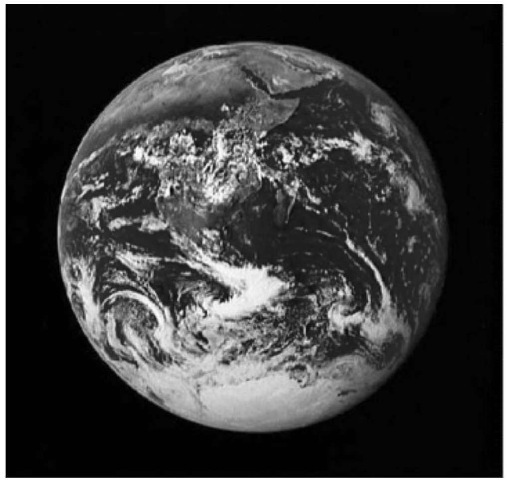
Figure 20. Apollo 17′s view of a nearly full Earth, photographed by the author from a distance of about 34,000 miles.
Other scientific implications of lunar exploration and research relative to understanding the other terrestrial planets and the asteroids are also profound. The Moon forms one end member in the planetary mass series Earth-Venus-Mars-Mercury-Asteroids-Moon (610). Having a detailed understanding of the nature and evolution of the two end members of this series, rather than of just Earth, has increased the value of remotely sensed data about the others by orders of magnitude. For example, new questions can be asked about the sequence of events during the formation of Earth’s core (611). Discrepancies between the apparent ages of Earth and the Moon (612) can be approached from new directions (613). Evidence indicating that primitive lead isotopic ratios, chondritic tungsten isotopic ratios, and increased aluminum exist in the lunar mantle below about 550 km strongly suggests that the Moon had an original chondritic core of about 1200 km in radius. Further, 182HF/182W systematics constrain the crystallization of most of the lunar Magma Ocean to within the first ~40 million years of solar system history. These data may indicate that the Moon evolved separately from Earth and was captured rather than originating as a consequence of a giant terrestrial impact. They also suggest that the original core of Earth, as well as those of Mars, Venus, and Mercury, would have been chondritic and comparable in size to the 1200-km protocore of the Moon. Initially, cool cores would have delayed metallic core formation resulting from the downward migration of iron-nickel-sulfur liquid separates from Magma Oceans. Age correlation of the start of global magnetism on the Moon with young, large impact basins indicates a delay of about 700 million years in lunar core formation. Prelarge-basin magnetic striping detected in highland units on Mars (614) suggests a shorter, possibly ~ 300 to 400 million year delay on that planet. On Earth, the delay may have been long enough to isolate radiogenic isotopic systems temporarly from magma ocean isotopic systems in an initially chondritic core. A delay in the mixing of these two systems after core formation may explain the paradox of model radioisotopic systems giving ages for Earth that are ~ 100 million years younger than the age of the Moon and meteorites.
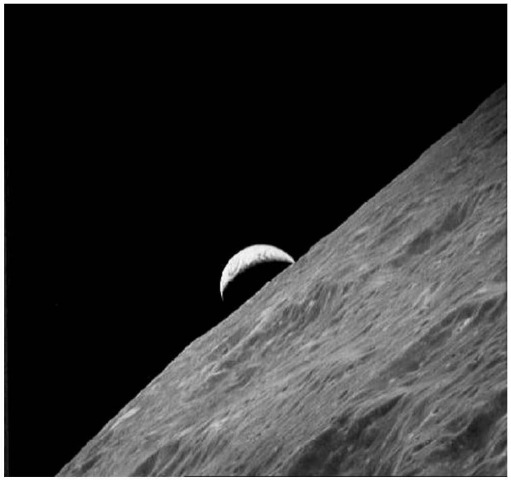
Figure 21. Apollo 17′s view of the rising crescent Earth from behind the Moon.
The nature of Earth’s crust when plate tectonic processes first began to assemble continents can be illuminated by joint consideration of the evolution of the Moon and Mars (615). Further, interpretations of spacecraft images and data from the other terrestrial planets invariably are considered first in the context of what we know about Earth and the Moon. The Asteroids, sampled by many meteorites and imaged by several spacecraft, can now be viewed confidently as largely the remains of a Moon-like planet, broken apart by interactions with Jupiter (616). Although our remotely sensed information about Mercury is limited compared to the other planets, Mariner 10 images and other data can be interpreted as disclosing a somewhat larger version of the Moon (617), but one that evolved much nearer the Sun and had a much larger metallic core. Global photography, orbiting sensors, and telerobotic landers have begun to illuminate the geologic history of Mars. Martian history now can be organized with reference to the sequence of major stages of lunar evolution, modified by our terrestrial experience with the effect of water and an atmosphere (618). Venus still holds many mysteries about its resurfaced crust in spite of the remarkable global coverage by the Magellan spacecraft’s radar system (619). Using that imagery, however, and our knowledge of Earth and the Moon, we know the questions to ask about underlying materials and structures and about samples when they can be obtained from the surface of Earth’s sister planet. Finally, the discovery of solar wind resources in the lunar regolith, particularly 3He as a potential terrestrial fusion energy fuel, has joined
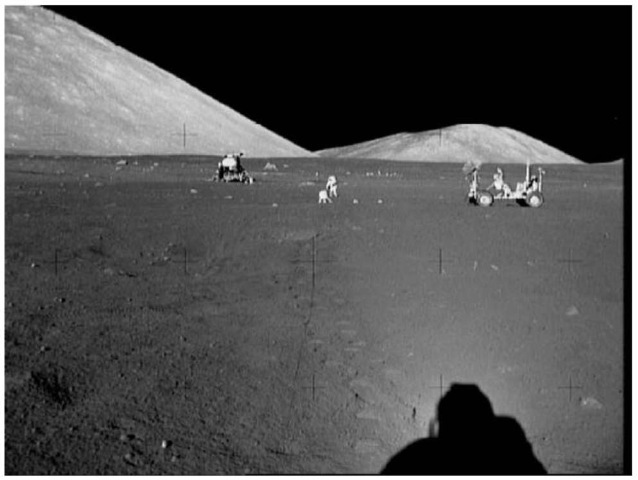
Figure 22. The Lunar Module Challenger at rest in the Valley of Taurus-Littrow on the Moon.
Earth and the Moon together as one environmental system for the future (Fig. 21). Our ability to be a truly spacefaring species in the foreseeable future may rest on the availability in space of lunar consumables, hydrogen, oxygen, water, and food. Ultimately, the returns on America’s investment in Apollo (Fig. 22) will turn out to be as large and immeasurable as they were for those stimulated by Thomas Jefferson in the Louisiana Territory, Abraham Lincoln in Alaska, and many other public and private commitments to exploration and science.


